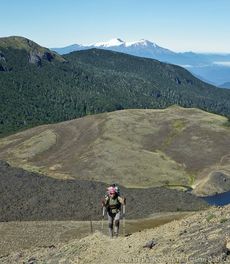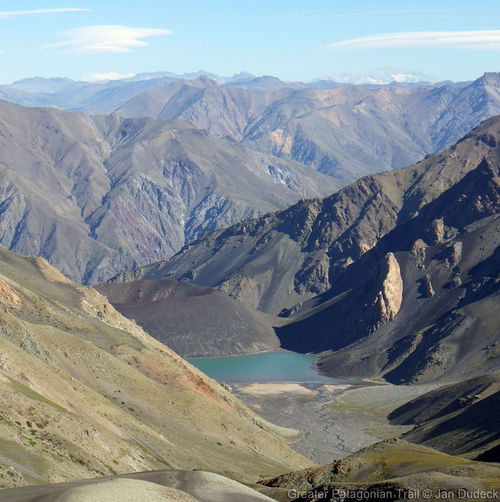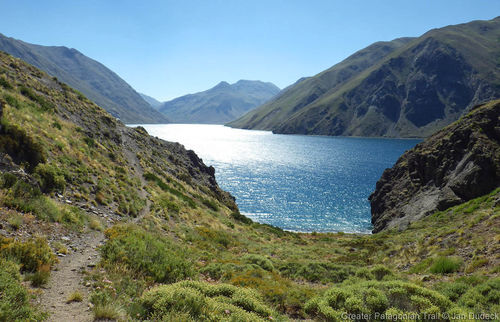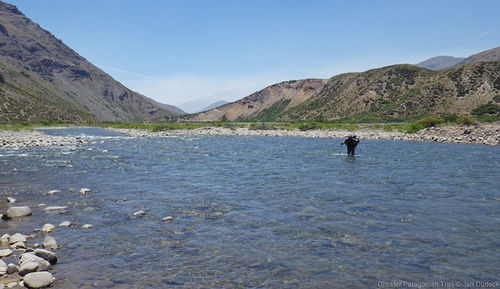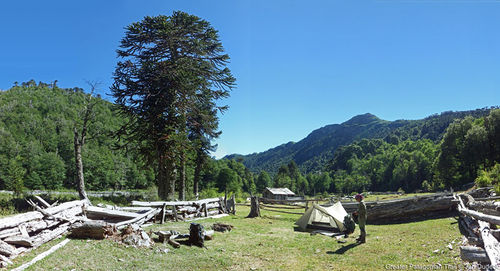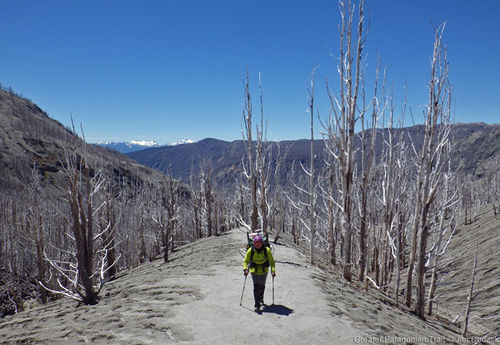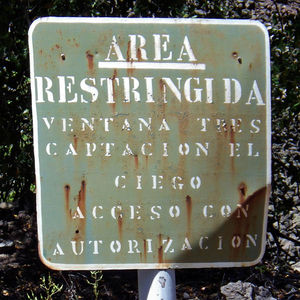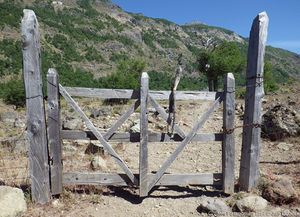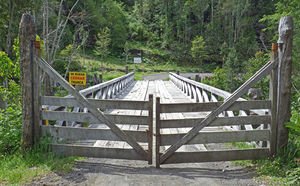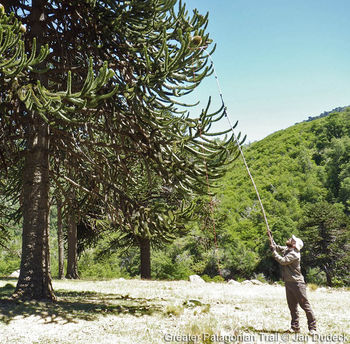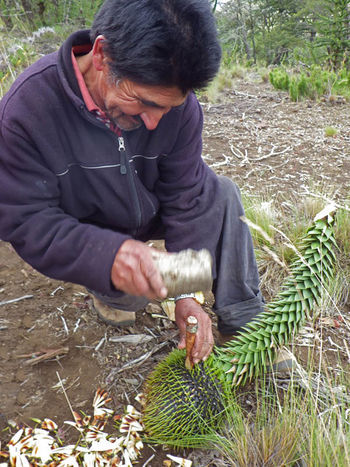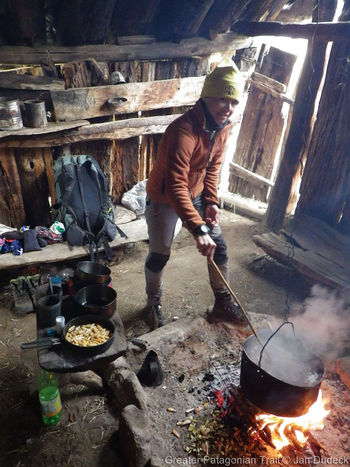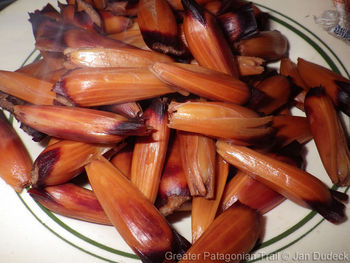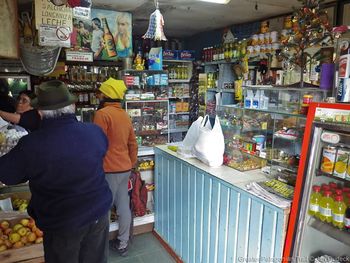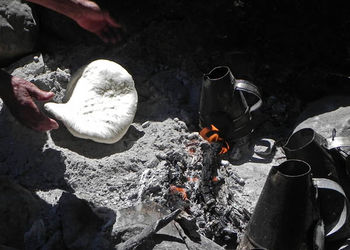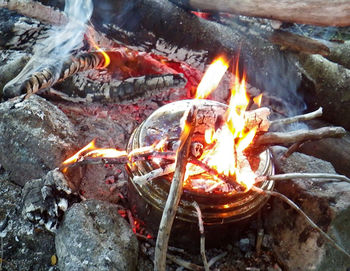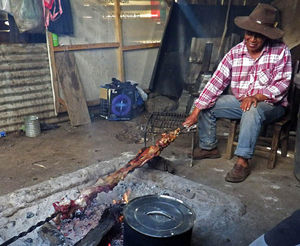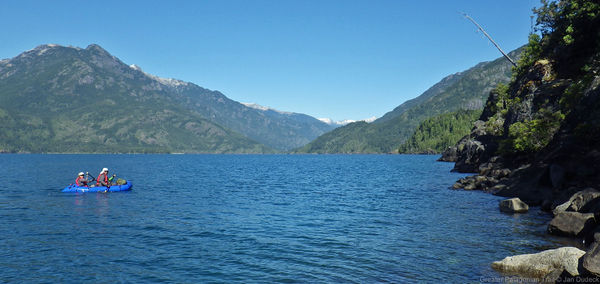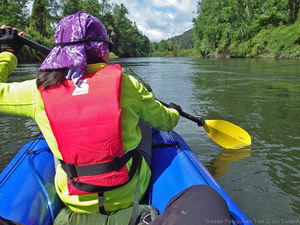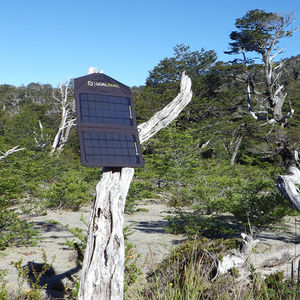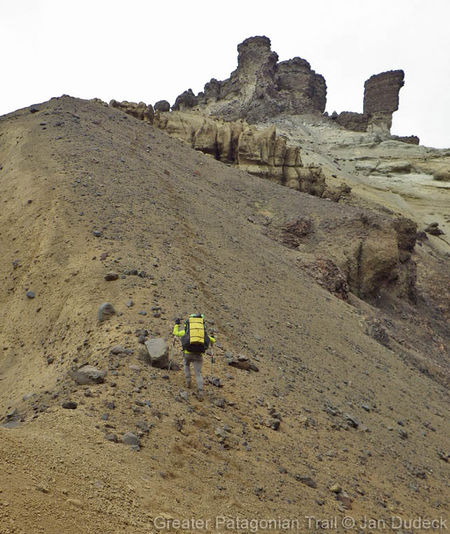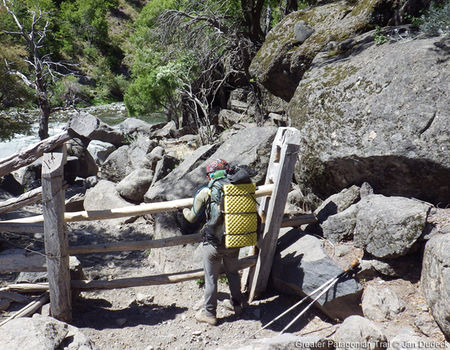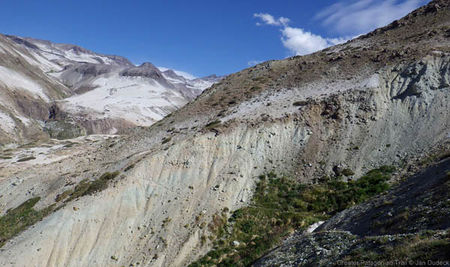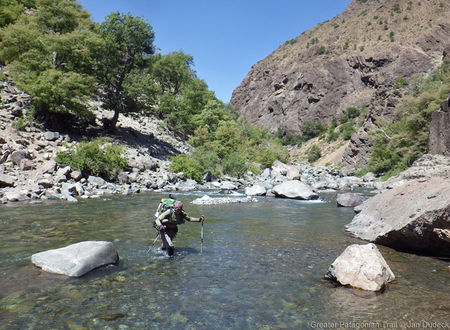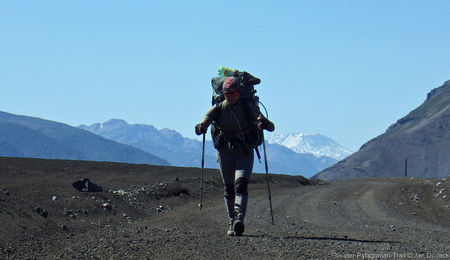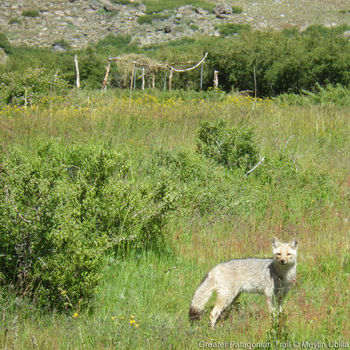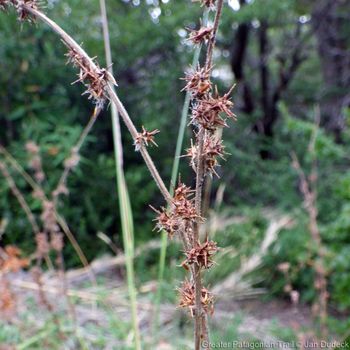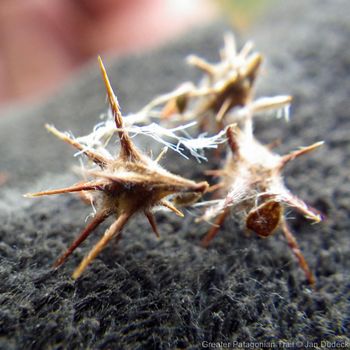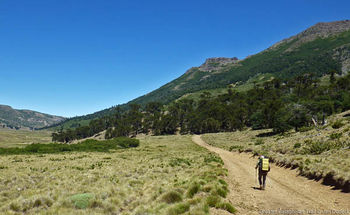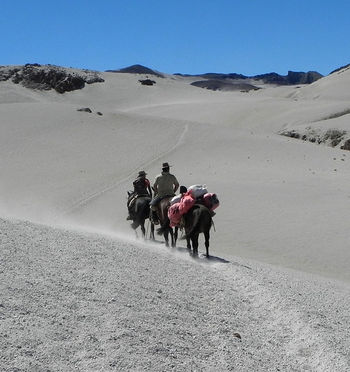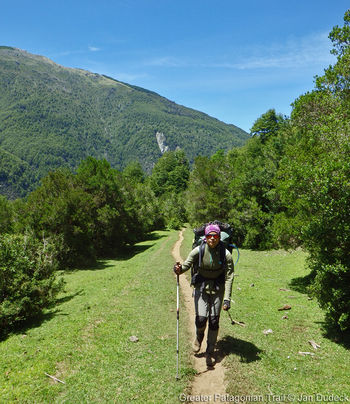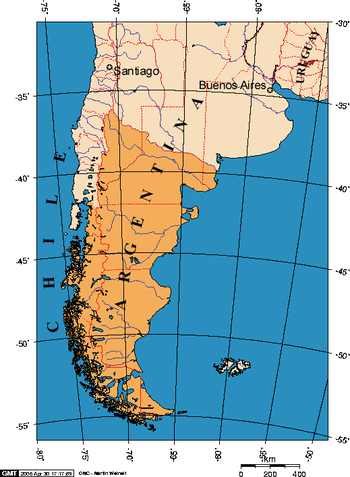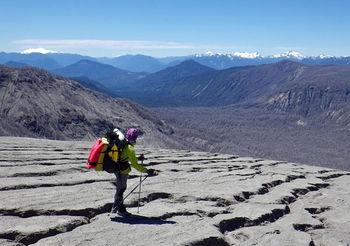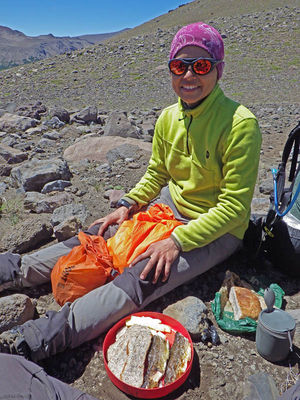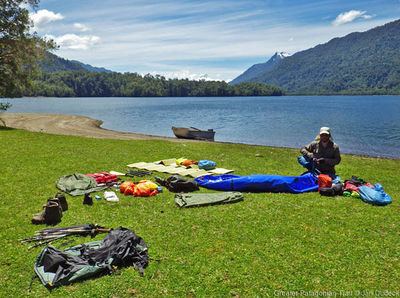Diferencia entre revisiones de «Greater Patagonian Trail»
m (Texto reemplazado: «Image:» por «File:») |
|||
| Línea 2: | Línea 2: | ||
{{RutaForm2 | {{RutaForm2 | ||
|Actividad=Trekking | |Actividad=Trekking | ||
| − | |||
|País=Argentina, Chile | |País=Argentina, Chile | ||
|CiudadesArgentina=El Bolsón | |CiudadesArgentina=El Bolsón | ||
| Línea 15: | Línea 14: | ||
|Infraestructura=Inexistente | |Infraestructura=Inexistente | ||
|TipoTrek=Recorrido | |TipoTrek=Recorrido | ||
| + | |ComparteIdayRetorno=Cruce | ||
|Distancia=1500 km | |Distancia=1500 km | ||
|Desnivel=50.000 metros | |Desnivel=50.000 metros | ||
Revisión del 17:35 18 oct 2016
|
| ||||||||||||||||||||||||||||||||||||||||||||||||||||||||||||||||
Summary
The Greater Patagonian Trail is a long distance trail that leads you right through the heart of the legendary Patagonian Andes. It's a stunningly beautiful and diverse trail that crosses volcanic fields, idyllic Andean valleys, snow covered mountain ranges, lush green forests and deep blue lakes and rivers.
On this 1500 km long trail you will meet herdsmen with their animals, indigenous Pehuenche on their homeland and courageous settlers that ventured into a challenging backcountry.
The Greater Patagonian Trail is not an official trail that was planned and set up by a government agency. It’s better: it’s a compilation of the most beautiful and diverse trails, neglected minor roads and cross country sections through the Patagonian Andes selected by a passionate hiker.
In several parts the trail branches into different routes giving you various choices. You may walk the entire trail or you can take a packraft with you to paddle over pristine mountain lakes and to float down on calm meandering rivers. You can also opt to climb up to the summits of several landmark volcanos on the trail. And if the regular route is not challenging enough for you than you can venture into even more remote backcountry.
Without any doubt substantially longer and more demanding hikes have been done on this continent. In the chapter Other notable Long Distance Trails and Hikes some remarkable adventures and epic hikes in this region are briefly described. The objective of this trail is not to top any of these achievements but to provide a well-documented and well-walkable trail for experienced and self-reliant hikers.
To the knowledge of the author the Greater Patagonian Trail is the first and currently only long distance hiking trail in South America that exceeds 500 miles / 800 km, that is documented in detail, is continuous without any trail gaps and largely avoids roads with transit traffic. For other long distance trails in the Andes see Other notable Long Distance Trails and Hikes.
Images
Here you find a selection of images from the Greater Patagonian Trail that are uploaded to Panoramio and displayed on Google Earth.
Used Trails
When planning the Greater Patagonian Trail the first choice were the hiking and horse trails that traverse the remote valleys and mountain passes in the heart of the Andes close to the border between Chile and Argentina. Most of these trails are created and maintained by local herdsmen to drive livestock to their summer pastures and by settlers that live in solitary.
The second choice were unused or rarely travelled minor dirt roads. Such often neglected roads typically provide access to isolated settlements or villages without attracting any transit traffic. Some of these roads are not maintained anymore and not accessible by vehicle but passable for hikers. Most hiking trails in Europe would fall in this category since the majority of hiking trails in Europe are occasionally used by forestry and agricultural vehicles.
Public roads with transit traffic were avoided wherever possible. On such major dirt roads you may find some moderate traffic but they are safe to hike.
Paved roads were the last choice of all.
In some areas the Greater Patagonian Trail crosses through open terrain without a visible trail. Some of these cross-country routes lead through steep and exposed terrain but do not require technical climbing. The cross-country parts also do not pass very dense vegetation and can be hiked without a machete to cut a trail. Valdivian and Magellanic temperate rainforests is very dense and is not suitable for hiking cross-country.
Not all hiking options are recorded yet by GPS since the author investigated the Greater Patagonian Trail with a packraft. There is also a shorter part that could not be hiked because one area was closed at the time of the investigation due to a large wild fire. These to be verified trails may therefore be imprecisely shown in this trail description and by the KMZ/GPX files. But the author has reliable information that these trails exist and have been hiked recently. At this time the author has simply no precise GPS record and the route is not sufficiently visible on satellite images.
Wherever possible the Greater Patagonian Trail incorporates lake crossings, river downstream floats and even paddeling on fjords with a packraft.If not carrying such a light-weight inflatable boat or if the weather does not permit paddling then all these water sections can be bypassed on foot, by ferry or with private boat transfers. The river downstream floats do not include white-water rivers with large rapids.
| Trail Type | Hiking Only Option | Packraft Option | Comment | ||
|---|---|---|---|---|---|
| Distance | Percentage | Distance | Percentage | ||
| Hiking and Horse Trails | 643 km | 46% | 494 km | 34% | Mostly visible trail on any terrain. |
| Minor Dirt Roads | 596 km | 42% | 506 km | 35% | No or light traffic only. Often also an abandoned road or a private road that is not open for public use. |
| Cross-Country | 83 km | 6% | 78 km | 5% | Track that pases through open landscape without a visible trail. |
| Mayor Dirt Roads | 66 km | 5% | 52 km | 4% | Public dirt roads with moderate transit traffic. |
| Paved Roads | 11 km | 0.8% | 8 km | 0.6% | Only few shorter segments at the start or finish of a sections. |
| Trail type to be verified | 8 km | 0.6% | 4 km | 0.3% | Unclear if hiking and horse trails or cross-country. |
| Ferry | (57 km) | (0.0%) | - | Distance covered by ferry not counted. | |
| Lakes (Packraft) | - | 218 km | 15% | Lake crossing with packraft. Alternative options are available if not carrying a packraft. | |
| Rivers (Packraft) | 58 km | 4% | River downstream float. Alternative hiking options are available if not carrying a packraft. | ||
| Fjords (Packraft) | 14 km | 1% | Fjord crossings with packraft. Alternative hiking options are available if not carrying a packraft. | ||
| Land to water ratio | |||||
| Hiking on Land | 1407 km | 100% | 1142 km | 80% | Combined distance on land (all trail types) |
| Packrafting on Water | - | 290 km | 20% | combined distance on water (lakes, rivers, sea) | |
| Recorded trail to not-yet-recorded trail ratio | |||||
| Recorded or Confirmed Trail | 1296 km | 92% | 1421 km | 99% | Trails that have been recorded by GPS or that are confirmed otherwise. |
| To be Recorded by GPS | 111 km | 8% | 11 km | 1% | Trails that need to be recorded by GPS to update the trail file. |
| Complete Trail | 1407 km | 1432 km | Complete trail without summits. The seven optional summits on the trail add 74 km. | ||
Expected Duration
The complete trail can be hiked in one summer season and requires approx. 90 to 120 days if walking with a moderate pace. This inculdes some rest days, resupply bus trips to nearby towns and an occasional day lost to bad weather. One "high-speed-hiker" has done sections 1 to 16 in about 50 days so you can be faster, but I suggest to take some time to enjoy the trail and allow yourself some lesure time while hiking in this pristine region.
If you do not have the time to hike the entire trail then you can customize your trail by selecting some sections only.
Trail Sections
The entire trail consists currently of 18 sections that require between 2 to 10 days each. The sections are between 35 km and 150 km long. Every section connects seamless with the following section and starts and ends near a road or village with public transportation. Therefore each section can be hiked as an individual trail or several sections can be combined to a longer trip.
| Section Name | Number | Country and Region/Province | Next City or Town | Start | Character |
|---|---|---|---|---|---|
| Volcán Descabezado | GPT01 | Chile, Maule (VII) | Curico, Molina | Radal | Volcanic Terrain, Lakes, Hot Springs |
| Laguna Dial | GPT02 | Chile, Maule (VII) and Bío Bío (VIII) | Talca, San Clemente | Ruta 115, El Melado (Near La Mina) | Mountain Pastures, Rivers, Lake, Hot Springs |
| Volcán Chillan | GPT03 | Chile, Bío Bío (VIII) | San Carlos, San Fabian de Alico | Pichirrincón, El Inglés | Mountain Pastures, Mountain Ridge, Volcanic Terrain, Rivers, Hot Springs |
| Volcán Antuco | GPT04 | Chile, Bío Bío (VIII) | Los Angeles, Antuco | El Abonico, Centro de Esquí Antuco | Volcanic Terrain, Lake, Mountain Pastures |
| Laguna El Barco | GPT05 | Chile, Bío Bío (VIII) | Los Angeles, Santa Barbara, Ralco | Trapa Trapa, Puente Ñirehueco | Araucaria Forest, Mountain Pastures, Lake |
| Guallali | GPT06 | Chile, Bío Bío (VIII) and Araucanía (IX) | Los Angeles, Santa Barbara, Ralco | Guallali, Puente Lomin | Araucaria Forest, Mountain Pastures, Rivers, Mountain Ridge, Hot Spring |
| Laguna Marinanqui | GPT07 | Chile, Araucanía (IX) | Temuco, Lonquimay | Ranquil, Carabiñeros | Araucaria Forest, Mountain Pastures, Rivers, Mountain Ridges |
| Volcán Sollipulli | GPT08 | Chile, Araucanía (IX) | Temuco, Lonquimay | Liucura, Aduana Pino Hachada | Araucaria Forest, Mountain Pastures, Rivers, Lakes, Indigious Settlements |
| Curarrehue | GPT09 | Chile, Araucanía (IX) | Villarica, Pucon, Currarehue | Reigolil | Araucaria Forest, Mountain Pastures, Rivers, Indigious Settlements |
| Volcán Quetrupillan | GPT10 | Chile, Araucanía (IX) and Los Ríos (XIV) | Villarica, Pucon, Currarehue | Puesco or Currarehue depending on route | Volcanic Terrain, Lakes, Araucaria Forest |
| Liquiñe or Neltume | GPT11 | Chile, Los Ríos (XIV) | Villarica, Coñaripe | Reyehueico, Puente Reyehueico (Near Liquiñe) | Rivers, Lakes, Temperate Rain Forest, Hot Springs |
| Lago Pirihueico | GPT12 | Chile, Los Ríos (XIV) | Panguipulli | Puerto Fuy | Lake, Temperate Rain Forest |
| Volcán Puyehue | GPT13 | Chile, Los Ríos (XIV) | Los Lagos, Futrono | Puerto Maihue | Volcanic Terrain, Lake, Temperate Rain Forest |
| Volcán Antillanca | GPT14 | Chile, Los Lagos (X) | Osorno, Entre Lagos | Ruta 215, Conaf Anticura (Near Aduana Pajaritos) | Volcanic Terrain, Lake, Temperate Rain Forest |
| Lago Todos Los Santos | GPT15 | Chile, Los Lagos (X) | Osorno | Lago Rupanco, Las Gaviotas (Near Puerto Rico) | Lakes, Fjord, Temperate Rain Forest |
| Cochamó | GPT16 | Chile, Los Lagos (X) and Argentina, Chubut | Puerto Montt, Puerto Varas, Ensenada | Cochamó | Lakes, Rivers, Temperate Rain Forest |
| PN Lago Puelo | GPT17 | Argentina, Chubut | El Bolson | Lago Puelo | Lakes, Rivers, Forest |
| PN Los Alerces | GPT18 | Argentina, Chubut | El Bolson, Esquel | Villa Rivadavia (Previously La Bolsa) | Lakes, Rivers, Forest |
| Current Finish | - | Argentina, Chubut | Esquel | Villa Futalaufquen | - |
See the Section Information below with further detailed information to each section.
Recommended Season
If you plan to hike the entire trail in the correct sequence starting with section 1 than you should leave in December, ideally in the second half of December.
On the first three sections several rivers and high mountain passes need to be crossed. In particular high river-water-levels during snowmelt may make the river crossings difficult and dangerous until December. Therefore leaving before or in early December may put you in risk when crossing rivers or traversing still snow covered passes. But if you leave after December you may be surprised by the heralds of the winter before reaching the finish of the Greater Patagonian Trail if walking in a moderate pace.
If you do not insist in hiking all trail sections in the correct sequence then you have more options when and where to start. If you want to leave before December you may in example set out in late October or November with section 11 in Liquiñe (Hiking-Only-Option) or in Reyehueico or Coñaripe (both Packraft-Option) as we did.
Coñaripe is a alternative start of section 11 for packrafters and the first of the 8 sections with significant packraft use. Starting with section 11 before December gives you the advantage of floating down the rivers with a comfortable high river-water-level during snow melt.
If you do not carry a packraft but wish to start in late October or November Liquiñe would be a good choice. Liquiñe is a village full of thermal springs and situated on the Hiking-Only-Option of section 11. This start avoids the potentially dangerous river-crossings of the first 3 sections and the rather high and exposed mountain passes of section 1, 2, 3, 6, 7 and 10. Once you reached the finish of section 18 you can travel by bus in about 3 days to the start of section 1 and hike all the way to the point from where you started the track.
On sections 5 to 10 the trail crosses the distribution range of the Araucaria tree. Between February and April the cones of these trees can be harvested and provide plenty of nutritious free food that you do not need to carry on your back. If possible arrange to cross sections 5 to 10 between February and April. This is one more very good reason for an early start on section 11 because then you can finish in the Auracaria distribution range in late summer or early autumn and feed yourself like a food gatherer millennia’s ago.
Even if hiking this trail in the recommended season be prepared for sudden weather changes with heavy snowfall, in particular when you are higher up in the mountains. Also rivers can swell anytime after heavy rain.
See the Section Information below that provides an orientation when each section is best be hiked.
Hiking Direction
The generally recommended trekking direction is southbound even if most sections can be hiked in either direction.
Some sections require an entrance permit if you hike northbound. This limitation applies to section 1 and 12 and the long distance challange that directly connects section 2 and 3 (GPT02-03). Without an entrance permit you may be “kicked out” but if you walk southbound this means leaving the property in the direction that you are hiking anyway.
If you are hiking with a packraft then section 11, 17 and 18 need to be taken southbound. Only in this direction you can float down the rivers in your inflatable boat. When hiking without a packraft these section can be taken in either direction using the alternative hiking trails.
For section 15 the recommended trekking direction is also southbound. If you go south you can ask shortly before reaching the Lago Todos Los Santos a local settler for a private boat transfer. In the other direction this may not work as easy. So if you do not have a packraft or if you are unsure that you really want to cross such a rather large lake with a tiny boat, then hike the section 15 southbound.
See the Section Information below with the recommended hiking direction(s) for each section.
Section Information
| Section Name | Number | Best Season |
Hiking- Only- Option |
Packraft-Option | Additional Hiking Options | Villages and towns on the trail or near the finish for resupply | |
|---|---|---|---|---|---|---|---|
| Direction Options |
Packraft Usage |
Direction Options | |||||
| Volcán Descabezado | GPT01 | Dec-Apr | South ↓ | Side trips only | South ↓ | Summit Descabezado, Hidden Lakes | On the way to the start: Santiago de Chile, Curicó, Molina After section finish: San Clemente, Talca |
| Laguna Dial | GPT02 | Dec-Apr | Any ↑↓ | May be used | Any ↑↓ | Laguna del Maule and El Troncoso, Laguna las Truchas | San Fabian, San Carlos, Chillán |
| Volcán Chillan | GPT03 | Dec-Apr | Any ↑↓ | Experts only | Any ↑↓ | Summit Chillan Viejo, Laguna las Truchas, Rio Nuble and Las Aguilas, Eastern Side of Laguna de Las Lajas | Antuco, Los Angeles |
| Volcán Antuco | GPT04 | Nov-May | Any ↑↓ | Experts only | Any ↑↓ | Summit Antuco, Around Antuco, Eastern Side of Laguna de Las Lajas | Ralco, Santa Bárbara, Los Angeles |
| Laguna El Barco | GPT05 | Dec-Apr | Any ↑↓ | Side trips only | Any ↑↓ | - | Ralco, Santa Bárbara, Los Angeles |
| Guallali | GPT06 | Dec-Apr | Any ↑↓ | Not used | Any ↑↓ | Summit Moncol | Lonquimay |
| Laguna Marinanqui | GPT07 | Dec-Apr | Any ↑↓ | Side trips only | Any ↑↓ | Laguna Escondida and Laguna Verde | Liucura on the trail, Lonquimay |
| Volcán Sollipulli | GPT08 | Oct-May | Any ↑↓ | May be used | Any ↑↓ | Summit Sollipulli, Icalma | Icalma and Reigolil on the trail, Curarrehue, Pucon |
| Curarrehue | GPT09 | Oct-May | Any ↑↓ | Not used | Any ↑↓ | Fundo Huililco | Curarrehue on the trail, Pucon |
| Volcán Quetrupillan | GPT10 | Dec-Apr | Any ↑↓ | Side trips only | Any ↑↓ | Summit Quetrupillan, Valle Termal | Liquiñe, Coñaripe, Pucon |
| Liquiñe (Hiking) | GPT11H | Oct-May | Any ↑↓ | May be used | Any ↑↓ | - | Liquiñe and Puerto Fuy on the trail |
| Neltume (Packraft) | GPT11P | Oct-May | - | Required | South↓ | - | Neltume and Puerto Fuy on the trail |
| Lago Pirihueico | GPT12 | Nov-May | South↓ | Beneficial | South↓ | - | Chabranco on the trail, Llifén, Futrono |
| Volcán Puyehue | GPT13 | Dec-Apr | Any ↑↓ | Beneficial | South↓ | Summit Puyehue, Hot Spring | Entre Lagos, Osorno |
| Volcán Antillanca | GPT14 | Dec-Apr | Any ↑↓ | Not used | Any ↑↓ | "La Plaza" | El Poncho, Puerto Rico, Panguipulli |
| Lago Todos Los Santos | GPT15 | Oct-May | South↓ | Experts only | South↓ | - | Ralún and Cochamó on the trail, Puerto Varas, Puerto Montt |
| Cochamó | GPT16 | Oct-May | Any ↑↓ | Beneficial | Any ↑↓ | - | Llanada Grande on the trail, Lago Puelo, El Bolson |
| PN Lago Puelo | GPT17 | Dec-Apr | Any ↑↓ | Beneficial | South↓ | - | Villa Rivadavia on the trail |
| PN Los Alerces | GPT18 | Dec-Apr | Any ↑↓ | Beneficial | South↓ | - | Villa Futalaufquen on the trail |
Trail Files for GPS and Google Earth
The KMZ file displayed on the satellite map above is optimized to provide a good overview but does not include any waypoints and shows only some of the optional routes. Therefore the files below in the next table should be downloaded and used if you actually plan to hike on the Greater Patagonian Trail. There are trail files for individual section and for the entire trial.
Different file formats are provide for reviewing the trail on a computer with Google Earth (KMZ) and for uploading the trails to a handheld GPS devise (GPX). All these file formats contain the same geographic information; mainly tracks and waypoints; but the different file formats have advantages and disadvantages when using them with different applications.
The KMZ file format is optimal for display and editing on a computer with Google Earth. In example tracks and waypoints can be organized in a folder structure what facilitates handling a large number of individual tracks and waypoints. Unfortunately a KMZ file cannot be uploaded directly to a Garmin GPS but needs to be converted first into GPX file (in example with the free Garmin "Basecamp" software). See also the wikipedia article for further information to the KMZ/KML file format.
The GPX file format is optimal for uploading the trail file(s) to a handheld GPS devise. This applies in particular to Garmin equipment. Also when using a handheld GPS devise it is of advantage to minimize the number of individual tracks. The Garmin devise that I use (GPSMap 62) is unable to display more than 200 individual track. Therefore numerous individual tracks that are in line were joined to minimize the number of tracks in the GPX files. See also the wikipedia article for further information to the GPX file format.
Therefore:
Reviewing and editing the trail on a computer in Google Earth: KMZ
Uploading the trail file(s) to a handheld GPS: GPX
The trail files for the hiking only options i.e. "GPT01-18H.kmz" have a H like "Hiking" in the file name. These trail files do not contain any of the packraft routes, neither the water parts itself nor the land hiking parts to the lakes and rivers from where you can continue only by packraft. This shall prevent that a hiker without a packraft takes by accident the wrong route and ends up on the shore of a lake or river from where he cannot continue on foot. So if you do not carry a packraft download the trail files for the Hiking-Only-Options.
In contrast the trail files for the packraft options i.e. "GPT01-18.kmz" contains all routes including all hiking routes. There might be good reasons i.e. strong wind or bad weather that make a hiker with a packraft opting for the hiking alternative to avoid in example a lake crossing under unfavourable conditions. So if you carry a packraft download the trail files for the Hiking-Only-Options AND Packraft-Options because these trail files show you all options.
For sections without any packraft parts only one section trail file is published (without an H in the file name).
Read also the comment to the trail files after downloading to understand the structure and nomenclature of this file.
| Section Name | Number | Hiking-Only-Options | Hiking-Only-Options AND Packraft-Options | |||||||||||
|---|---|---|---|---|---|---|---|---|---|---|---|---|---|---|
| Distance | Ascent | Descent | Days | Time | Trail File | Distance | On Water | Ascent | Descent | Days | Time | Trail File | ||
| Volcán Descabezado | GPT01 | 103 km | 5000 m↑ | 4900 m↓ | 6-8 d | 35 h | GPT01.gpx GPT01.kmz |
See hiking option. Packraft may only be used on side trips. | GPT01.gpx GPT01.kmz | |||||
| Option: Summit Descabezado | 16 km | 2000 m↑ | 2000 m↓ | 1-2 d | 9 h | |||||||||
| Laguna Dial | GPT02 | 143 km | 5300 m↑ | 5300 m↓ | 7-10 d | 44 h | GPT02H.gpx GPT02H.kmz |
141 km | 9 km (6%) | 4600 m↑ | 4700 m↓ | 7-10 d | 42 h | GPT02.gpx GPT02.kmz |
| Volcán Chillan | GPT03 | 129 km | 6500 m↑ | 5900 m↓ | 7-10 d | 44 h | GPT03H.gpx GPT03H.kmz |
123 km | 23 km (19%) | 4800 m↑ | 4200 m↓ | 7-10 d | 40 h | GPT03.gpx GPT03.kmz |
| Option: Summit Chillan Viejo | 15 km | 1300 m↑ | 1300 m↓ | 1 d | 7 h | - | ||||||||
| Volcán Antuco | GPT04 | 57 km | 1400 m↑ | 1800 m↓ | 3 d | 16 h | GPT04H.gpx GPT04H.kmz |
59 km | 9 km (16%) | 1300 m↑ | 1700 m↓ | 3 d | 17 h | GPT04.gpx GPT04.kmz |
| Option: Summit Antuco | 9 km | 1600 m↑ | 1600 m↓ | 1 d | 6 h | - | ||||||||
| Laguna El Barco | GPT05 | 43 km | 1500 m↑ | 1500 m↓ | 2-3 d | 13 h | GPT05H.gpx GPT05H.kmz |
See hiking option. Packraft may only be used on side trips. | GPT05.gpx GPT05.kmz | |||||
| Guallali | GPT06 | 50 km | 2500 m↑ | 2300 m↓ | 3-4 d | 17 h | GPT06.gpx GPT06.kmz |
See hiking option. Packraft can not be used on this section. | GPT06.gpx GPT06.kmz | |||||
| Option: Summit Moncol | 3 km | 200 m↑ | 200 m↓ | 0 d | 1 h | |||||||||
| Laguna Marinanqui | GPT07 | 82 km | 2900 m↑ | 3000 m↓ | 5-7 d | 25 h | GPT07H.gpx GPT07H.kmz |
See hiking option. Packraft may only be used on side trips. | GPT07.gpx GPT07.kmz | |||||
| Volcán Sollipulli | GPT08 | 96 km | 2600 m↑ | 2800 m↓ | 5-6 d | 27 h | GPT08H.gpx GPT08H.kmz |
93 km | 9 km (9%) | 2300 m↑ | 2500 m↓ | 5-6 d | 26 h | GPT08.gpx GPT08.kmz |
| Option: Summit Sollipulli | 11 km | 1000 m↑ | 1000 m↓ | 1 d | 5 h | - | ||||||||
| Curarrehue | GPT09 | 77 km | 2500 m↑ | 2300 m↓ | 3-5 d | 23 h | GPT09.gpx GPT09.kmz |
See hiking option. Packraft can not be used on this section. | GPT09.gpx GPT09.kmz | |||||
| Volcán Quetrupillan | GPT10 | 50 km | 1700 m↑ | 2500 m↓ | 3-5 d | 15 h | GPT10H.gpx GPT10H.kmz |
See hiking option. Packraft may only be used on side trips. | GPT10.gpx GPT10.kmz | |||||
| Option: Summit Quetrupillan | 13 km | 900 m↑ | 900 m↓ | 1 d | 5 h | |||||||||
| Liquiñe and Neltume | GPT11 | 35 km | 1800 m↑ | 1400 m↓ | 2 d | 12 h | GPT11H.gpx GPT11H.kmz |
40 km | 22 km (56%) | 700 m↑ | 300 m↓ | 2 d | 12 h | GPT11.gpx GPT11.kmz |
| Lago Pirihueico | GPT12 | 71 km | 2500 m↑ | 3000 m↓ | 4-5 d | 22 h | GPT12H.gpx GPT12H.kmz |
86 km | 22 km (26%) | 2300 m↑ | 2800 m↓ | 4-6 d | 26 h | GPT12.gpx GPT12.kmz |
| Based on two recent feedbacks the section between the waypoints "Diversion (GPT12-WP020)" and "Trail Start (GPT12-WP023)" is badly overgrown and very difficult pass. Therefore this section should only be attempted by a group of at least two persons with sufficent reserve food and time. A machete should be carried to clean the overgrown trail. | ||||||||||||||
| Volcán Puyehue | GPT13 | 81 km | 4200 m↑ | 3900 m↓ | 4-6 d | 28 h | GPT13H.gpx GPT13H.kmz |
71 km | 10 km (14%) | 3000 m↑ | 2700 m↓ | 4-5 d | 23 h | GPT13.gpx GPT13.kmz |
| Option: Summit Puyehue | 8 km | 800 m↑ | 800 m↓ | 1 d | 4 h | - | ||||||||
| Volcán Antillanca | GPT14 | 39 km | 1800 m↑ | 2000 m↓ | 2-3 d | 13 h | GPT14.gpx GPT14.kmz |
See hiking option. Packraft can not be used on this section. | GPT14.gpx GPT14.kmz | |||||
| Lago Todos Los Santos | GPT15 | 59 km | 2100 m↑ | 2200 m↓ | 4-5 d | 18 h | GPT15H.gpx GPT15H.kmz |
85 km | 40 km (48%) | 1800 m↑ | 1900 m↓ | 5-6 d | 25 h | GPT15.gpx GPT15.kmz |
| Cochamó | GPT16 | 151 km | 5900 m↑ | 5700 m↓ | 7-10 d | 47 h | GPT16H.gpx GPT16H.kmz |
145 km | 33 km (23%) | 4600 m↑ | 4500 m↓ | 7-10 d | 45 h | GPT16.gpx GPT16.kmz |
| PN Lago Puelo | GPT17 | 86 km | 3600 m↑ | 3300 m↓ | 5-7 d | 27 h | GPT17H.gpx GPT17H.kmz |
76 km | 41 km (54%) | 2200 m↑ | 1800 m↓ | 5-7 d | 24 h | GPT17.gpx GPT17.kmz |
| Based on one recent feedback the ascent to the waypoint "Pass (GPT17-WP101)" is badly overgrown and very difficult pass. Therefore this section should only be attempted by a group of at least two persons with sufficent reserve food and time. A machete should be carried to clean the overgrown trail. Alternatively try a other trail shortly before the waypoint "Bridge (GPT17-WP010)" that remains in this valley. To the knowledge of the author this trail also becomes overgrown after 6 to 7 km but may connect after a difficult to pass part with the waypoint "Camp (GPT17-WP105)". | ||||||||||||||
| PN Los Alerces | GPT18 | 58 km | 2000 m ↑ | 2000 m ↓ | 3-4 d | 17 h | GPT18H.gpx GPT18H.kmz |
72 km | 71 km (99%) | 0 m↑ | 0 m↓ | 3-4 d | 21 h | GPT18.gpx GPT18.kmz |
| Complete Trail without Summits | 1407 km | 56000 m↑ | 56000 m↓ | - | 442 h | GPT01-18H.gpx GPT01-18H.kmz |
1432 km | 290 km (20%) | 46000 m↑ | 46000 m↓ | - | 442 h | GPT01-18.gpx GPT01-18.kmz | |
| Complete Trail with 7 Summits | 1481 km | 64000 m↑ | 64000 m↓ | - | 478 h | 1506 km | 290 km (19%) | 54000 m↑ | 54000 m↓ | - | 479 h | |||
See the Section Table above with the recommended season, hiking direction, hiking options and resupply villages and towns.
Read also the comment to distances, ascents, descents and walking times to correctly understand the recording, calculation and relevance of these numerical values.
Recent Feedback and Updates to the Trail
| Section Name | Number | Date | Name | Feedback and Update |
|---|---|---|---|---|
| Volcán Descabezado | GPT01 | - | - | - |
| Laguna Dial | GPT02 | - | - | - |
| Volcán Chillan | GPT03 | - | - | - |
| Volcán Antuco | GPT04 | - | - | - |
| Laguna El Barco | GPT05 | - | - | - |
| Guallali | GPT06 | - | - | - |
| Laguna Marinanqui | GPT07 | - | - | - |
| Volcán Sollipulli | GPT08 | - | - | - |
| Curarrehue | GPT09 | - | - | - |
| Volcán Quetrupillan | GPT10 | - | - | - |
| Liquiñe (Hiking) | GPT11H | - | - | - |
| Neltume (Packraft) | GPT11P | - | - | - |
| Lago Pirihueico | GPT12 | Nov/Dec 2015 | Elliot, Hevré, Sören | Based on two recent feedbacks the section between the waypoints "Diversion (GPT12-WP020)" and "Trail Start (GPT12-WP023)" is badly overgrown and very difficult pass. Therefore this section should only be attempted by a group of at least two persons with sufficient reserve food and time that want to "dive" into the Valdivian rain forest. All other hikers should bypass section 12 by bus. Hikers who attempt this section should carefully search a suitable connection between the two above mentioned waypoints and carry a machete to clean the overgrown trail. Whenever using a machete care should be taken to not leave misguiding cut marks. Keep in mind that hikers after you will follow your cut marks therefore clearly block "death end" trails and leave clear signs i.e. cut marks that guide others after you along a suitable route. |
| Volcán Puyehue | GPT13 | - | - | - |
| Volcán Antillanca | GPT14 | - | - | - |
| Lago Todos Los Santos | GPT15 | - | - | - |
| Cochamó | GPT16 | - | - | - |
| PN Lago Puelo | GPT17 | Dec 2015 | Eliot, Hevré | Based on one recent feedback the ascent to the waypoint "Pass (GPT17-WP101)" is badly overgrown and very difficult pass. Also the Huella Andina trail from the start of section 17 along the eastern side of the Lago Puelo was partly damaged by a large wild fire in January and February 2015. Therefore this section should only be attempted by a group of at least two persons with sufficient reserve food and time. All other hikers should bypass section 17 by bus. Hikers who attempt this section should should carry a machete to clean the overgrown trail. Alternatively ask the local settlers to guide you i.e. to get up to the ridge and walk along the tree-less ridge to the waypoint "Pass (GPT17-WP101)". A other option is trying an alternative trail shortly before the waypoint "Bridge (GPT17-WP010)" that that follows the valley "Derrumbe". To the knowledge of the author this trail also becomes overgrown after 6 to 7 km but may connect after a difficult to pass part with the waypoint "Camp (GPT17-WP105)". |
| PN Los Alerces | GPT18 | - | - | - |
Long Distances Challanges
The sections 2 and 3 can be combined with an alternative trail through a pristine area that bypasses the settlement and the road at the finish of section 2 and the start of section 3.
The sections 3 and 4 may also be combined by packrafting the entire Laguna Las Lajas or taking a cross country route on the eastern side of the lake. Both, the packraft and the hiking option, are quite challanging and the optional cross country trail still needs to be verfied. This alternative route bypasses the road to the town Antuco and the tiny ski resort on the base of the volcano Antuco.
It is even possible to combine sections 2, 3 and 4 in a extra-long super-section without passing a single village. This tripple section is a true long distance endurance challange that gets you in 3 to 4 weeks through nearly untouched wilderness. If you attempt it, you should be well aware of all the exit routes to walk out in time if you run out of food.
Combining sections 4 to 7 should be considered when hiking these sections. You may get some basic food i.e. in Trapa Trapa at the end of section 4 and in Guallali on section 6. You may also ask the Puesteros along the trail for food or harvest Araucaria cones to "stretch" the food that you carry in your backpack and make it last this long combined section. This would save you resupply bus trips to "nearby" villages and towns. Such resupply bus trips take two days or more due to the distances and the low bus frequency. In particular getting at the end of section 6 by bus to Lonquimay and then back to continue with section 7 might be an ordeal.
Also combining sections 13 to 15 is advisable to save you time consuming resupply bus trips. At the end of section 13 you may ask in a settlers home for food and at the end of section 14 you may take the ferry that runs three times per week to a tiny village, resupply in a small shop just next to the embarkation point and return shortly later with the same ferry.
| Section Name | Number | Hiking-Only-Options | Hiking-Only-Options AND Packraft-Options | |||||||||||
|---|---|---|---|---|---|---|---|---|---|---|---|---|---|---|
| Distance | Ascent | Descent | Days | Time | Trail File | Distance | On Water | Ascent | Descent | Days | Time | Trail File | ||
| Section 2 and 3 via Las Truchas |
GPT02-03 | 279 km | 12700 m↑ | 12100 m↓ | 14-20 d | 91 h | GPT02-03H.gpx GPT02-03H.kmz |
271 km | 32 km (12%) | 10400 m↑ | 9700 m↓ | 14-20 d | 86 h | GPT02-03.gpx GPT02-03.kmz |
| Section 3 and 4 East of Laguna de Las Lajas |
GPT03-04 | 174 km | 7200 m↑ | 7000 m↓ | 10-15 d | 55 h | GPT03-04.gpx GPT03-04.kmz |
166 km | 26 km (15%) | 5800 m↑ | 5600 m↓ | 10-15 d | 52 h | GPT03-04.gpx GPT03-04.kmz |
| Section 2, 3 and 4 via Las Truchas and East of Laguna de Las Lajas |
GPT02-04 | 324 km | 13400 m↑ | 13200 m↓ | 17-25 d | 103 h | See above | 313 km | 35 km (11%) | 11400 m↑ | 11100 m↓ | 17-25 d | 98 h | See above |
| Section 4 to 7 | GPT04-07 | 231 km | 8300 m↑ | 8600 m↓ | 13-17 d | 70 h | See above | 233 km | 9 km (4%) | 8200 m↑ | 8500 m↓ | 13-17 d | 71 h | See above |
| Section 13, 14 and 15 | GPT13-15 | 178 km | 8100 m ↑ | 8200 m ↓ | 10-15 d | 59 h | See above | 194 km | 50 km (26%) | 6600 m↑ | 6600 m↓ | 10-15 d | 62 h | See above |
Trail Altitude Profile
The following two images show the altitude profile of the trail. The first images shows the Hiking-Only-Options and the second images shows the route with all Packraft-Options incorporated. Both altitude profiles exclude all optional ascents to summits.
Entrance Permits and Fees
The Greater Patagonian trail is not an official trail that is set up and managed by a government agency. Is simply a compilation of horse trails, minor roads and some cross country sections that pass over private properties and state owned land.
Nearly the entire trail can be hiked without entrance permits or paying entrance fees. And what is even better: many of the humble people that live along the trail will welcome you or even invite you to stay. Here hospitality matters!
But there are a few exceptions; some are already briefly mentioned above under Hiking Direction.
Unfortunately the public right of way is vague and sometimes ignored in Chile. By Chilean law the access to the coast, to lakes and to rivers is a public right but there are numerous locations where this gets disregarded. There are simply no penalties if someone unlawfully denies passage. I'm not sufficiently familiar with Chilean law to state if a similar public right of way applies to all the connecting trails and roads on private properties. But if it exists it’s occasionally disregarded. Some rich landlords with huge plots employ guards and instruct them to deny access to anyone.
Entrance Permits and Challenges
Section 1
Laguna Mondaca: I was recently advised that a signpost was place at the pass between the Laguna Las Animas and the Laguna Mondaca denying access to the Laguna Mondaca. If you want to avoid a discussion with an overeager guard at this lake you may take the short cut that leads you directly to the hot springs “Termas de Asufre”. Otherwise you may be asked to continue on the regular trail after having reached the lake.
Hydropower Station Cipreses: The Hydropower Station Cipreses is owned by Endesa and controls the valley between the Route 115 and the Laguna de La Invernada. Permanently manned gates control the northbound access from the Route 115 but there are no similar barriers when entering the property southbound over the mountains in example when coming from the volcano Descabezado. An access permit can be requested in advance and is normally granted. See the wikiexplora article "Laguna y Cráter Los Hornitos" for further information.
Long Distance Challange that directly connects Section 2 and 3
Fundo Las Truchas: The fundo Las Truchas is owned by a regional big farmer. When he purchased this ranch he first kept it open for public access to the attractive Laguna Las Truchas. Unfortunately some locals don’t treat their environment with respect and litter or fish without limits. The owner got annoyed and now denies public access in particular to local citizen. When entering the fundo Las Truchas northbound you may be send back by the guard, who lives 2 km south of the Laguna Las Truchas from late spring to autumn. If entering southbound you may be asked to leave the property in the direction you are hiking anyway.
Section 3 "Bad Weather Exit Route"
Hydropower Station El Toro: The Hydropower Station El Toro is owned by Endesa and controls the valley Rio Polcura upstream of Abanico. A permanently manned gate controls the northbound access from Abanico. There are no similar controls when entering the property southbound from the Laguna de Las Lajas. An access permit may be requested in advance but no specific information are available where this can be done. Anyway, this restriction is not of much relevance since the regular trail on the ridge can be hiked in either direction. You only get to the Hydropower Station El Toro if get down from the ridge on the "Bad Weather Exit Route".
Section 12
Reserve Huilo Huilo: During the later days of the Pinochet Regime large parts of the state owned forest around the Lago Pirihueico were sold under obscure circumstances to the German immigrant Victor Petermann. He later converted the forest into a “private for profit natural reserve”. The emphasis seems to be the profit and not so much the natural reserve. Permanently manned gates now limit access to guests of the luxury resorts on this immense property. Wood logging continues in more hidden parts of the “profit reserve”. When we attempted to take the former public road from Puerto Fuy to Pirihueico we were turned back on several of the gates. For this reason we took the ferry over the lago Piriheuco and walked the same road but from the other side where we did not encounter any manned gates or objections. See the wikipedia article to the Complejo Forestal y Maderero Panguipulli.
Fundo Chihuio: The fundo Chihuio is situated north of the Termas de Chihuio and owned by a rich businessman. The guard lives at the southern entrance to the ranch. He is instructed to deny access to the former public road towards Puerto Fuy and Pirihueico. When hiking southbound you will leave the property at the entrance where the guard lives.
Section 13
Fundo Carrán: The Fundo Carrán is located south of the Lago Maihue. We crossed the Lago Maihue southbound by packraft and entered the fundo Carrán unknowingly from the shore of the Lago Maihue. We than walked about 5 km until we reached a locked gate just before a public road. We could easily climb over the locked gate to continue on the public road. On this locked gate is a signboard that prohibits public access.
Entrance Fees
Section 13
Southbound Access to Cordon Caulle: A very fiendly and helpful older couple lives at the northern access to the Cordon Caulle and volcano Puyehue. They own the forest with the road that provides access to volcanic area where 2011 a major eruption occured. They offer shelter if the weather does not permit a crossing of the volcanic plateou. In 2013 they charged a 6'000 CLP entrance fee.
Northbound Access to Cordon Caulle: The restaurant "El Caulle" is situated at the southern access to the Puyehue and Cordon Caulle. They maintain the refuge higher up on the foot of the volcano Puyehue. In 2013 they charged a 10'000 CLP entrance fee but no "exit fee".
Conclusion
When challenged on the trail explain friendly that you are just a hiker and that you do not want anything else than passage to the next road or town. Hikers are rarely seen on most of the route and some people may suspect other interests because they simply don't know the concept of hiking. You may explain how far you already walked to gain the sympathy and respect of the guard or land owner. Guarantee that you will carry all your waste and that you will not leave any traces.
What we experienced on the trail seems to mirror the attitude of the Chilean society: The humble poor people on the trail opened the doors to their houses to give us shelter and they literally shared their bread with us without asking for money. But some of the super-rich denied passage over their immense properties on which they normally don’t even live when kindly asking for permission to pass.
Logistical Considerations
Tourist Visa
The vast majority of citizens from Europe and North-America do not need a visa to visit Chile as a tourist. These citizens receive a tourist permit that allows them to stay up to 90 days in Chile. With an estimated duration of 90 to 120 days it is possible to complete the first 16 sections on Chilean soil in 90 days but leaves little margin for rest days or weather related delays.
The easiest way to renew your permit is travelling to Argentina before completing your 90 days and returning a few days later to Chile. On re-entry you will normally be granted another 90 days. Such a trip can be combined with a resupply stop in a nearby town.
Recommendable "visa trips" with public transportation are:
- Section 9: From Curarrehue in Chile to Junin de Los Andes or San Martin de Los Andes in Argentina
- Section 13: From Osorno in Chile to San Carlos de Bariloche in Argentina
Alternatively you can request a tourist visa extension in Chile. This can be done in any of the 54 provincial capitals of Chile. Los Angeles, Temuco and Puerto Montt are 3 possible choices but none of the provincial capitals are conveniently close to the trail. Here you find a full list of the Chilean provinces with its capitals: Wikipedia: Provinces of Chile.
If you do not start the trek at section 1 but do sections 11 to 18 first you will cross the border from Chile to Argentina on foot on section 16 and renew your tourist permit when returning to Chile. This will give you enough time to hike sections 1 to 10 in a comfortable pace.
If you insist in not taking any bus or motorized vehicle during the entire trek you have three options:
- You hurry up to cross into Argentina on section 16 within 90 days counted from your arrival in Chile.
- You can walk on foot from Icalma in Chile to Villa Pehuenia and back (Section 8, 16 km one way).
Importation of Food
Chile is very cautious when it comes to importing food, plants and animals. To minimize the risk of introducing pests, invasive plants and animals such imports are highly regulated and controlled. Therefore individuals are strictly banned to bring fresh fruits, vegetables, raw milk or meat products to Chile. Only processed sterile food can be imported in concealed packing’s, in example all heat treated canned items in closed containers. Thorough checks are performed by the SAG (Servicio Agrícola y Ganadero) on the airport and the border checkpoints from neighbouring countries.
- Example of strictly banned items:
- Fresh and dried fruits
- Fresh cheese
- Raw meat and raw meat products like ham and sausages
- Honey
- Example of normally accepted items:
- Bread, cookies and other baked items
- All canned items even if containing milk and meat products
- Sweats like chocolate, candies and cereal bar
- Cereals, corn flakes and chocolate powder
- Pasta, rice, flour and dehydrated potato puree
- Instant meals like dehydrated trekking food in concealed bags
When crossing the border to Chile you need to fill in a declaration if you are carrying any plant or food products. On this declaration the definition for plant or food products is very wide and includes all the permitted items as well. Therefore the best and only correct thing is to always state YES. If ask explain that you are aware of the restrictions and that you carry processed food and give examples.
If you state NO but something banned is found you will be charged a high fine.
You should also clean your boots from visible mud since mud may contain seamen of invasive plants.
Theoretically the same rules apply when crossing into Argentina but controls are often much more relaxed and you do not need fill and sign a declaration.
Resupply at Nearby Towns
There are no proper shops along the first seven sections of the trail. The first regular food store on the trail comes after 600 km at the finish of section 7. But there is a road with public transportation at the end of each section that gives you the opportunity to take a bus and to travel to the next village or town to resupply. See the table under Section Information with suitable resupply villages and towns.
In the larger cities, in example in Santiago, Talca, Chillan, Los Angeles, Osorno and Puerto Montt you find "Jumbo" supermarkets. To our impression these supermarkets offer the widest range of dehydrated food that is suitable for hiking. These supermarkets have typically a section of imported food items from Europe and North America. Here we found in example well-seasoned couscous imported from Canada, potato fritters that comes as a powder imported from Germany and dehydrated deserts that you just need to mix with cold water and milk powder to make in example a very tasty chocolate cream after your dinner. If you are fancy on good cooking in the wild then take your time and stroll through the aisle of the supermarket and try something new.
Resupply by Bus
The product range in smaller villages and towns is limited. In particular dehydrated trekking food may not be offered at all. If you prefer to have some special stuff that you find only in Santiago or that you bring with you from overseas you have the following option: You pack a box with food and other gear in Santiago and send the box with one of the mayor bus companies to a town where you plan a resupply stop. To send the box you do not need any address in this town; all you need to do is making yourself the recipient of your own package. The bus company will ship your box to this town in 1 or 2 days and store it until you pick it up. There you can take out of your box whatever you need and resend the box with the remaining stuff to the next resupply town where it will be stored again. Storage of up to 30 days is free of charge. This transport service by busses is called "encomienda" and functions like a postal service. Unfortunately this service is only available in larger cities. Therefore this service cannot be used to ship resupplies directly to the trail.
I advise you not to use this service offered by JAC. They lost one of our packages and were incredible poorly organized and ignorant to give us at least the legally required minimum refund (which was far less than the actual value). Turbus made at least a more organised impression when compared to JAC. Anyway, you should better not send valuable items i.e. a packraft but only items whose loss does not jeopardize your trip. If you plan to send valuable items anyway you should have at least the original purchase receives of these items with you. If you present these receipts before sending the package you may increase the refund value in case of loss to a substantially higher value. Without such a receipt only a rather small value can be declared (50,000 to 100,000 CLP depending on the company) and gets refunded in case the shipment is lost by the company.
Suitable resupply towns with bus cargo stations are (bus company in brackets):
- Talca (Turbus)
- San Carlos (Turbus)
- Chillán (Turbus)
- Los Angeles (Turbus)
- Pucon (Turbus)
- Osorno (Turbus)
- Puerto Montt (Turbus)
- Puerto Varas (Turbus)
See also the table with the Section Information for a full listing of resupply towns on or near the trail.
A true thru-hike without resupply bus trips would require the setup of food depots on strategic points along the route.
Food Supply on the Trail
On this trail, in particular on the first seven sections you will meet herdsman on the summer pastures with their livestock, which are mainly cattle, sheep, goats and horses. Depending on the altitude and the snowmelt they migrate up between October and January and return to their winter quarters in April or May. These herdsman, locally called "Puestero", live in improvised permanent shelters, called "Puesto". They bring large quantities of food with their horses and mules up into the mountains. You may ask them for food, in particular for flour and bread or whatever they are willing to sell. With flour, dry yeast and salt you can bake your own fresh bread on the trail. If you are desperate for meat they may sell you a goat or a sheep but be aware, the smallest quantity for sale is typically half an animal (Spanish: "Medio Canal"). To communicate with the locals you need to speak Spanish.
On section 5 to 10 you will cross the distribution range of the impressive Araucaria trees, which are ancient evergreen coniferous trees. What we liked on these living fossils were not just the imposing figure, but the nutritious female seed cones that are rich in carbohydrates. These fruits or "piñones" were the main staple food for the indigenous Pehuenche people and they taught us how to harvest and prepare them. You can gather these starchy Araucaria "piñones" between February and April.
Traditional Food
This is not a listing of all the standard trekking foods like pasta and cereals. If you attempt this long distance trail you should know all this by heart. This section lists and describes selected traditional food items that are typical for this region but may be less known outside or named differently.
Piñones: As already mentioned under Recommended Season and Food Supply on the Trail you can become a gatherer on sections 5 to 10 and collect a good part of your food yourself along the trail if you pass this area between February and April. You just need to get the timing right and carry a strong string to harvest the mature cones of the female Araucaria trees. According to Wikipedia the name Araucana is derived from the native Araucanians who's main staple food were the nuts or seeds of the Araucaria tree. A group of Araucanians living in the Andes, the Pehuenches, owe their name to their diet based on harvesting of the Araucaria seeds. Pehuen means Araucaria and che means people in the native language Mapudungun.
The natives use a lasso to harvest the mature cones. As a hiker you probably will not carry a rather heavy lasso but you may bring a strong string with you. By trial and error we eventually choose to connect long sticks in example branches, bamboo grass and/or our hiking poles to lift a sling over a single cone and then break the cone off by pulling against the growth direction. Once you have the cone down you can open the cone with a wedge and a stone as shown on the picture above. The seeds then need to be separated and boiled for about 30 minutes with the husk. Once boiled the husk can be easily removed. Just squeeze the husk and the eatable seed will slip out easily. You can eat the seed simply cooked or fry them later.
Harina Tostada (Chile) or ñaco (Argentina) is toasted ground wheat and the staple food of the herdsmen. It comes as a brownish powder and tastes like corn flakes but it needs to be mixed first with a liquid to eat. The most common form is mixing with water but also beer, wine or juice can be used. Also sugar may be added if mixed with water. Depending on the mixing ratio it will be a thick paste or a liquid and makes a perfect snack during the days. Try yourself and find out how you like it most. You can buy it in all rural stores but also the big super markets sell it. It's the perfect trekking food because it's nourishing and takes little space in the backpack. See the wikipedia article for more information to this versatile staple food.
Tortilla de Rescoldo is a white bread that was backed in the hot ash of a fire. Most puestos don't have a proper oven to bake bread but use the accumulated ash of the fireplace instead. The dough is made as usual with wheat flour, salt and (dry) yeast. After the dough was prepared and given the typical rest the dough is gently put in a pit in the hot ash and then also covered with hot ash. After about 10 to 15 min the bread is turned and covered with hot ash again to bake it evenly on both sides. To not burn the bread the hot ash must be free of glowing charcoal. It requires quite some experience to get the temperature and the timing right. Also the fireplace must be in use for days or weeks to accumulate sufficient ash. A typical campfire will not work because the fire itself is to hot and amount of ash is insufficient.
To make fresh bread on the trail our self we used our two stainless steel pots and the lid. With some self-made wire clips we suspended the slightly smaller pot within the bigger pot. This creates a small but fully functional oven because the air gap between both pots protected the content from burning when placed in or next to the fire. With this oven we did not only bake fresh bread but also pizza and an onion pie. It needs some trial and error to learn how to get the temperature right and regular turning help to bake the content evenly.
Sopaipilla (Chile) or Torta Frita (Argentina) is fried white bread. The same standard dough made with wheat flour, salt and (dry) yeast and given the typical dough rest period of 15 to 30 minutes. Round flat dough-cakes are formed with a hole in the middle and gently put into a pot of hot oil of fat over a fire. The hole in the middle is required to move and removed the Sopapilla with a stick.
Chivo or Cordero al Palo: Puesteros occasionally butcher a male goat or sheep when they meet with other herdsmen or when they receive a visit to share an abounded and delicious meat feast. Female animals are normally preserved to maintain the flock so mainly the male goat get sacrificed(a rare example of male discrimination). The skinned and cleaned animal is cut into pieces and stack on a wooden pole ("palo" in Spanish). The pole is then placed next to the fire and regularly turned until the meat is ready to eat. It's crucial that the meat is well cooked to kill all potential parasites. You need to be lucky to arrive just in time for such a feast. Alternatively you may ask the puesteros along the route if they have some meat left or if they are willing to sell one animal and butcher and prepare it with you. The smallest quantity for sale is typically half an animal ("medio canal"). Once the meat is well cooked over the fire you can carry the left overs and consume it during the next two or three days.
Yerba Mate is a energizing caffeine-rich hot drink. You fill about half a cup with the tee-like "yerba", pour hot water over it and drink it with a special straw that acts at the same as an filter. This straw is called "bombilla". You can pour again and again water over it to keep drinking. Sharing mate with other people is a common ritual in these region. You will certainly be offered this rather bitter drink when you meet and chat with the locals. See also the wikipedia article to Mate for more information.
Mote are wheat grains, which were boiled and removed from its husk and then dried again for long term storage. Mote is probably not an optimal trekking food because it needs to be soaked in water for several hours before boiling. But settlers and herdsmen often carry mote and use it as an ingredient for stews and other meals.
Recommended Equipment
Packraft and Drysuite
A packraft is a light-weight inflatable boat designed to be carried in the backpack when not needed but to carry the backpacker and his backpack over lakes and rivers when he needs it. A packraft is not required for this trail but quite beneficial on sections 11, 12, 13, 15, 16, 17 and 18. It may also be used on sections 2, 3, 4 and 8. On section 1, 5, 7 and 10 it can be used for smaller side trips on lakes that are located next to the trail.
Here you find some images of our packraft. We use the "Explorer 42" from Alpackaraft. The total weight of the two-person-boat with paddles, two drysuites, waterproof bags and water gear is approx. 8 kg or 4 kg per person if shared.
I strongly recommend the use of a drysuite whenever paddeling in this area regardless of the size of the river, lake of fjord. This is the only suiteable protection against hypothermia in case you get wet or you get out of the boat on the water. Be aware that water temperatures are often quite low. Wind can suddenly increase and build up high waves in a matter of minutes that splash you wet with cold water or even flip your boat. Also on most rivers, lakes and fjords that are included in the packraft route suitable exit points are scarce. So don't rely on getting quickly out of the water when needed. The first two years we paddled without using a drysuite but I consider this now a beginner's mistake.
The packraft did not made us faster but made our trip much more diverse. It is just great to walk to the shore of a lake or river, take the backpack down, inflate the boat, store the gear, take a seat and paddle off. A packraft brings an other "dimension" into the trip.
Section 1 to 20: At two larger lakes you can alternatively take a daily ferry (Lago Pirihueco) or a private boat transfer (Lago Todos Los Santos). For all other lakes and rivers alternative trails, which circumvent the water are included in the Trail Files for GPS and Google Earth above. So you can bypass on foot all paddle parts if you do not have a packraft or if i.e. wind and weather do not permit the crossing of a lake with a rather tiny boat.
Section 21 to 27: In Palena the Hiking-Only-Option and the Packraft-Option of the Greater Patagonian Trail take a completely different routes. Both option rejoin briefly on Section 26 in the area of Cerro Castillo. When taking the Packraft-Option you do not have an easy connection to the Hiking-Only-Option so be well prepared to paddle long distances when taking this route.
Enter lakes, fjords and rivers with your packraft only in suitable weather conditions. Note that on sunny days wind typically increases substantially around noon and often blows very strong till the evening. Therefore packrafting on lakes and fjords is something for early risers.
Most but not all lakes have a predominant wind direction. The route is choosen in way that you have more likely favourable wind from the back than wind against you but on some lakes the predominant wind will blow you right into face. Most but not all river sections are relatively well wind-shilded. In particular the last part of Río Palena and Río Ibañez are quite exposed to wind.
If weather is unsuitable for packrafting take the alternative hiking options around the water or simply wait for better weather but do not jeopardize yourself.
The Packraft-Option also enters two fjords that are connected with the Pacific; the Estuario de Reloncaví on Section 16 and the Fjordo Pipiplena on Section 22. Here tides strongly affect water levels and currents. Understand the the tide cycles and get a current tide chart before before you enter these waters. In certain areas of these fjords tidal currents can outpace your packraft. Both fjords are best entered with a falling tide just after high tide. Also be very cautious when camping on the shore of these fjords and better avoid it. Make sure that you camp above the spring tide level. The trift wood on these shores can indicate you to what level the water may rise.
GPS and Electronic Map
The trail is mostly unmarked and only smaller fractions are documented with maps. Long stretches of the trail are only vaguely visible and frequently the trail peters out or divides into several branches. Therefore a GPS is absolutely essential for navigation. You need a handheld GPS devise to which you can upload the trail files. Spare batteries or recharge options are required to keep the GPS devise functional long enough.
In addition an electronic topographical map is recommended.
We used a Garmin GPS with the Garmin TOPO Chile Deluxe electronic map (TOPO Chile Deluxe sold for 80 USD). The topographical profile, rivers, lakes, road and towns are precisely mapped. Only smaller streams, smaller lagoons and some trails are partly incorrecly placed on this electronic map. The Garmin TOPO Chile Deluxe is more precise than the TOPO Andes (see below) and has more details but covers only Chile and is good for section 1 to 16 only.
Garmin now offers also an electronic topographical map that covers all Chile, Argentina and Bolivia (TOPO Andes sold for 100 USD). If you are planning to hike the entire trail and future extensions to the south then the TOPO Andes map is the suitable choice.
I do not recommend the purchase of paper maps. The Chilean Instituto Geográfico Militar (IGM) offers topographic maps with a scale of 1:50'000 for the entire Chile but these maps often do not contain the trails and may be outdated. There are a few hiking maps for some popular areas showing some but not all trails that are used by the GPT. So the extra cost and additional weight of paper maps do not justify to my opinion the minor benefit of paper maps.
If you are looking for an backup devise to your handheld GPS you may consider the inReach Explorer from Delorme which is not only a satellite tracker but can also be setup as navigator. I do not recommend this devise as a substitude for a handheld GPS due to the small screen, the limited battery life the limited number of tracks and waypoints that can be uploaded. But in case your handheld GPS fails, gets damaged or lost the inReach Explorer is a suitable backup if setup with the route and selected waypoints before starting the trip.
Satellite Tracker
The Greater Patagonian Trail leads partly through rather isolated uninhabited areas with no mobile phone coverage at all. In case of an accident a satellite based emergency communication devise may contribute to your survival.
- SPOT offers a light weight emergency beacon that when pushing an emergency button submits a distress signal via satellite with your GPS position to a rescue centre. This devise can also be set up to regularly send the GPS position in 10 minutes intervals and to display the hiked track on a map in the internet. We carried such a personal satellite tracker and our families and friends stayed much more relaxed because they could see us move day by day through the mountains. Unfortunately this devise is not particular reliable in Patagonia due to the satellite coverage. Based on our experience only 5% to 20% of the position signals are submitted successfully when hiking in this area. Therefore if you wish to keep your family and friends updated with a SPOT you need to purchase and activate the tracking option while hiking. This ensures that at least some positions are submitted successfully every day. In theory you can manually submit an "OK" message without purchasing the tracking option but this may result in rather long "black-out" periods since many signals don't get submitted successful and the devise itself does not provide any feedback if the signal was transmitted correctly or not. The other limitation of this devise is, that is cannot receive any messages or send messages written on the trail. SPOT requires you to choose one of the annual satellite data contracts so if you need it only for a few weeks or a few months you are forced to pay for more than you acetaully need. You find further information to this devise on the SPOT manufacturers homepage.
- InReach from Delorme offers a similar devise but without the above mentioned limitations. The inReach uses the more reliable Iridium satellite network that covers in particular the area towards the poles much better what favours its use in Patagonia. This devise also always provides a feedback if the position signal or message was send successful or not and keeps trying until the information is actually received. This devise can send position signals in regular intervals for display on an online map, the inReach is able to send and receive 160-character text messages with the GPS coordinates to mobile phones or email addresses and it can post updates to social media. And when pushing the emergency button a distress message is send via satellite with your GPS position to a rescue centre. The InReach itself is more expensive than a SPOT and it drains the batteries sligthly faster but the InReach is clearly the more reliable option. In contrast to a SPOT devise you do not need to opt for an annual data contact but you can choose the satellite data contract only for the months you really need it. Therefore I consider the InReach from Delorme a much better choice if compared with the SPOT. If you opt for the InReach Exporer and you set it up with the route before the trip than you also have a backup devise for your handheld GPS. See the inReach manufacturers homepage for more information.
Solar Battery Charger
The partly long stages and the limited supply along the trail requires a proper power management for the GPS, the camera and all other electronic gear you may carry with you. We opted for a solar power panel to recharge all our batteries while hiking. Carrying regular batteries for up to 3 weeks would have meant a substantial extra weight. We choose the model Nomad 7 from GoalZero with the Guide 10 Plus Power Pack.
Required Skills and Capabilities
The Greater Patagonian Trail requires endurance not only because of the total trail lenght but the rather long trail sections. The first three sections exceed 100 km each without regular resupply points on the route. If combining sections the distances become even larger and can reach or exceed 300 km.
Hiking this trail requires a detailed planning and preparation before and during the hike. The gear needs to be reduced to what is essential. Before each section the correct type and quantity of food needs to be selected and carried.
The isolation of some parts of the trail demand a self-reliant attitude and cautious behaviour. The hiker needs to feel confident and move safely in various terrains, that reach from snow covered mountains passes to dense tempered rain forests.
Sudden weather changes may happen anytime in this mountainous region. The hiker needs to be prepared and equipped to master in example an surprising snow storm and closing in clouds while crossing a mountain pass.
Good navigational skills are essential since the route is mostly unmarked. The hiker needs to recognize and follow the often only vaguely visible trails that frequently peter out or divides into several branches. Here the hiker needs follow his "sixth sense" while verifying and comparing the taken route with the recommended GPS tracks. Good knowledge in setting up and using a GPS is compulsory.
This trail should only be attempted with at least some Spanish knowledge and practice. You need to be able to introduce yourself, explain what you are doing, buy food and other supplies and organize your bus trips to and from the trail. Hardly anyone along the trail speaks or understands even a few words in English.
The following skills are NOT required:
- Rock climbing
- White water rafting
- Any super-man-capabilities
Code of Conduct
The trail leads mostly through unspoiled wilderness with little human intervention. And where you meet some settlers or herdsmen you are welcome and get treated as honourable guest. To maintain this I plead all hikers to follow this code of conduct:
- Leave no trace and in particular no litter. All packings that can be carried with content can be returned when empty.
- Make camp fires only where permitted and where and when it is safe to do so. Don't light a fire in dried out areas or when wind can carry sparks that may ignite nearby vegetation. Use only death wood and put the fire out with plenty of water. Don't leave the fire or go to sleep before having it put out completely.
- Don't abuse the hospitality of the people along the trail and pay fairly for what they share with you. Using a trail or camping in a not maintained place should be free of charge but if you get invited to a meal or use a camping ground that was installed by a local settler pay what you are asked for or what you would get charged in other places. Don't ruin the hiker's reputation by misusing the generosity of humble people. They sometimes might refuse to take your money but insist because they need it; it's part of the hospitality.
- Near a puesto you find often a good camp spot because the grazing animals create and maintain nice patches of grass. If the puesto is inhabited always introduce yourself and ask first for permission before pitching your tent. This also calms down the dogs.
- If you are caught by bad weather feel free to knock on doors and ask kindly for shelter. Helping in such situations is part of the ethics in the mountains.
- Don't enter locked puestos except in emergencies. This is also for your safety since poorly ventilated and maintained puestos pose a Hanta virus infection risk. See also Deseases.
- Leave all gates in the condition as you found them. If a gate was closed, close it after you. If a gate was open, leave it open.
- If you meet people on horses on a narrow trail step to the side and let them pass. It's for your own safety.
- Respect the rights of the land owners. Don't dispute over rights of way but ask kindly for permission to pass.
Dangers and Annoyances
Trail Condition
The Greater Patagonian trail is not an official trail that is set up and managed by a government agency. Is simply a compilation of horse trails, minor roads and some cross country sections over private properties and state owned land. This means that large parts of the route are not monitored or maintained by public authorities. Most of the horse trails were created by local herdsman to drive livestock to their pastures and other parts of the route are current or disused wood logging roads. Therefore the maintenance depends on the needs and initiative of these locals users.
Severe weather, volcanic eruptions and earthquakes can destroy or alter a route and if not maintained vegetation can completely close a trail within a few years in particular in the tempered rain forest. Therefore attention and good judgment are needed when hiking the Greater Patagonian Trail because some trail sections may become impassable or change. Check your GPS regularly but don’t follow blindly the GPS track.
Check also the recent feedback and updates to the trail shortly before starting your hike and during your adventure whenever you have the opportunity i.e. during the resupply stops. This table will be used to share updates provided by hikers. All hikers are encouraged to open an account on wikiexplora to enter updates to the trail in this table them self.
In worst case you need to turn around and seek an alternative route. A GPS with sufficient backup power and a detailed electronic map is essential in such a situation.
River Crossings
River Crossings are possibly the greatest hazard on this route in particular if attempted during inappropriate times or at not suitable locations. Snowmelt or heavy rain can raise the water level substantially and make a rivers crossing impassable that during other times is easily forded. Also the bed of a river can change and a location that once was suitable for crossing can became too deep or rapid. Therefore do no rely on the GPS waypoint for river crossings but always judge the situation yourself before attempting to ford a river. You may seek an alternative location along the river or turn around and take an alternative route if a river crossing is hazardous.
Rivers should only be crossed with shoes and hiking poles for added stability. If hiking together cross the river in pairs with arms firmly joint together. If the ford is wide enough you may cross the river not perpendicular to the flow direction but inclined in the flow direction. Some even recommend to carry and use a rope for difficult river crossings.
Isolation
Some parts of the Greater Patagonian Trail cross rather isolated areas. In some areas you can walk for days without seeing another human being. Therefore be prepared to help yourself in case of an accident. Always carry a sufficient first aid set.
If you are unable to continue it might take weeks or more for someone else to pass and mobile phone coverage is very limited along the trail. Therefore a satellite based emergency communication devise may contribute to your survival. SPOT offers a light weight emergency beacon that when pushing an emergency button submits a distress signal via satellite with your GPS position to a rescue centre. For further information see the recommended Satellite Tracker.
Weather
Storms with heavy rain may arise on all parts of the trail anytime and in elevated areas heavy snowfall may occur even in midsummer. Therefore be always prepared and equipped for sudden weather changes.
In bad or instable weather do not climb a pass or venture into exposed terrain above the tree line. Rather wait or return and seek shelter if the weather changes in a concerning manner. Carry at least a poncho to protect yourself and your backpack if rain or snow closes in. In instable weather keep your eyes open and memorize potential protected camp sites and puestos if you are forced to turn around to seek shelter. Selected suitable locations are documented with waypoints in the KMZ file for trekking.
While hiking we were told about several incidents along the trail where local inhabitants and outside tourists got lost, disappeared without trace or froze to death in bad weather. Don’t add another story!
Sun
Don’t undermine the sun, in particular when crossing large snow fields or large camps of bright volcanic ash. A proper head cover, sun cream and sun glasses are essential to prevent sun-burns and snow-blindness. Don’t just carry this stuff but use it preventively.
Snow-blindness can disable you for a few days if you did not wear sun glasses while crossing large snow fields in bright sunlight. The effect of snow-blindness are normally not felt until several hours after exposure when the symptoms (pain, intense tears, eyelid twitching, discomfort) become evident. See also the wikipedia article to Photokeratitis.
Volcanic Eruptions
The Greater Patagonian Trail snakes through the Southern Volcanic Zone and passes and crosses numerous volcanos. The trail is therefore plastered with signs of volcanic activities. Hot springs and beautiful mountain lakes that were dammed up by lava flows are the "sunny side" of these volcanic activities; widespread devastating destruction is the other. Several major eruptions occurred in the vicinity of the trail in recent years and parts of the trail were temporarily closed due to increased volcanic activities.
Therefore hikers should be aware how to act in case of a volcanic eruption:
- Respect the volcano alerts and do not venture into areas that were closed by local authorities.
- Some volcanos show an increased seismic activity shortly before an eruption therefore series of smaller earthquakes may announce an imminent eruption. If you are close to a volcano get ready to run!
- Know your possible escape routes in case of a surprising eruption. Be aware that small streams and rivers that origin at the flanks of a volcano often rise immediately and become instantly impassable during an eruption. Therefore seek higher ground if you are next to such a swelling river.
- In case of an eruption get distance between you and the volcano. If you have more than one option try to get out of the ash rain. Consider that the predominant wind direction is from west to east.
- Try to get to a settlement since local authorities will do their best to evacuate the affected population.
Earthquakes
Two of the ten heaviest earthquakes in the 20th and 21st century had their epicentre near the Greater Patagonian Trail. The 1960 Valdivia earthquake had a magnitude of 9.5 and the 2010 Bio-Bio earthquake had magnitude of 8.8. In the first 15 years of this century more than 300 earthquakes with a magnitude of 5.0 or more occurred in the area of the trail. Therefore don't be too surprised if the ground below you starts to move. (Data retrieved from USGS for the area from -35°S to -45°S and -75°W to -70°W, the large majority are aftershocks of the major Bio-Bio earthquake in 2010)
An earthquake may lose rocks, trigger landslides and cause tsunamis. Therefore be cautious when selecting your place to camp. Avoid pitching your tent in areas where scree and rubble indicates a hazard zone below rocks and cliffs. If you get hit by an earthquake while walking look up to check the area above you for liberated material that comes towards you and seek shelter. If a heavy earthquake occurs while walking or camping next to a fjord or a lake get on higher ground in case of a tsunami. Be aware that a landslide into a lake may cause a tsunami on a lake shore.
Wild Animals
There are no bears in South America. This makes hiking more relaxed if compared with North America. You can cook at your tent and store all you food in your tent without fearing a visit of a hungry bear.
The largest living predator in Patagonia (apart from humans) is the Puma, also called Cougar or Mountain Lion. They normally hide and avoid contact with humans. Wikipedia states: “Attacks on humans are very rare, as cougar prey recognition is a learned behaviour and they do not generally recognize humans as prey. (…) As with many predators, a cougar may attack if cornered, if a fleeing human stimulates their instinct to chase, or if a person "plays dead". Standing still however may cause the cougar to consider a person easy prey. Exaggerating the threat to the animal through intense eye contact, loud but calm shouting, and any other action to appear larger and more menacing, may make the animal retreat. Fighting back with sticks and rocks, or even bare hands, is often effective in persuading an attacking cougar to disengage.”.
For more information see: Cougar attacks on humans on wikipedia.
Wild boar: Are other potentially dangerous animals. They were introduced by humans and became an invasive species. These omnivores range in particular the Araucania and love Araucaria "piñones". Wikipedia states: “Although wild boars do not generally pose a threat to people, they occasionally attack humans. (…) Male boars become most aggressive during the mating season and may charge at humans at such times. Occasionally, female boars will attack if they feel their piglets are threatened, especially if a human physically comes between them and their young. Although a majority of boar attack victims recover with medical treatment, fatalities do occasionally occur.”
For more information see: Wild boar aggression towards humans on wikipedia.
Fox: The Chilla or Grey Fox populates the southern cone of South America and can be found on both sides of the Andes in Chile and Argentina. Their diet is varied and includes small and medium mammals, carrion, birds, reptiles and fruits. They sometimes attack small livestock in particular young goats and sheep but there are no records of attacks on humans. Foxes do not always show fear of humans and sometimes approach camp sites at night in search of food. Therefore do not leave any food outside of your tent but also not your smelly boots. In one camp site a fellow hiker missed one of his shoes in the morning. The park ranger later told us that this was not the first time that a fox has stolen a stinking shoe because foxes find intensive smell attractive.
Domesticated Animals
Dogs: Most settlers and herdsmen have several dogs to protect their home and their animal. They often show an aggressive behaviour when approaching a home or a puesto but calm down when the owner shows up and talks with you. Therefore keep distance to the dogs as long as the owner is not in sight. Many settler and herdsmen discipline theirs dogs by throwing stones after them. Therefore collecting stones and get ready to throw them keeps dogs often in distance.
Cattle: Cattle are normally rather peaceful but bulls and cows with calves may become aggressive and attack if they feel threatened. Therefore keep distance and do not try to pet them.
Insects
Horse-Flyes or Tabanos will form an annoying aerial escort on some parts of the trail. They are abundant in December and January in humid parts of the River- and Lake District. These rather noisy flyers get attracted by dark moving objects in bright sunlight. So avoid dark cloth and do not try to chase them off with rapid movements, otherwise your will attract the attention of more of them. They inflict painful bites but do not leave an itching stitch.
Spine and Bur-Bearing Plants
Along the entire trail you will encounter again and again anoying Cenchrus plants with spine-covered seeds, that use bypassing animals to spread their seeds (and now also hikers). Common names include buffelgrass, sandburs and sand spur. When the seeds of these leg-high plants ripen then the very sharp spines harden and the seed easily detaches from the stem.
The ripe seeds stick to most fabrics and can penetrate deep into the skin therefore be very careful when removing these thorny tiny balls from your cloth with your fingers. You can minimize "your collection" by wearing trousers made of a hard dense fabric. I had several times a not visible broken off spin in a fingertip that resulted in a small wound that did not heal for days until I removed the spine by cutting into the skin and removing the remaining spine tip manually.
Other less bothersome but still anoying plants have bur-bearing seeds that stick to soft cloth like fleece but do not penetrate into the skin.
Deseases
The most dangerous animal for humans in Patagonia is a quite small one: the long-tailed pygmy rice rat (Oligoryzomys longicaudatus) and the long-haired grass mouse (Abrothrix longipilis). These two species are known to carry and transmit a particular aggressive strain of Hantaviruses with a mortality rate of 30% to 40%.
The typical incubation time is 1 to 3 weeks but also cases with 3 to 45 days between the suspected exposure and the disease outbreak have been reported. Early symptoms are similar to a flu and include fatigue, fever and muscle aches. Other possible symptoms are headaches, dizziness, chills, nausea, vomiting, diarrhoea and abdominal pain. Seek medical attention if you experience such symptoms.
Wikipedia states: “There is no known antiviral treatment, but natural recovery from the virus is possible with supportive treatment. Patients with suspected hantavirus are usually admitted to the hospital and given oxygen and mechanical ventilation support to help them breathe during the acute pulmonary stage. As the virus can be transmitted by rodent saliva, excretia, and bites, control of rats and mice in areas frequented by humans is key for disease prevention.”
For more information see: Hantavirus on wikipedia.
The main source of infection are inhaled aerosols of mice droppings. Therefore the recommended preventive measures are:
- Avoid any contact with mice and mice dropping.
- Do no use any shelters that are not well ventilated or where you can see any traces of mice.
- Keep your food protect and away from mice in particular during the night. The same applies to your pots, dishes and waste to not attract mice.
- Camp in clean, open area that do not provide hideouts for mice. Avoid shrubbery.
- Use a tent with a closed floor and a fully concealed inner tent.
- Drink only secure water and disinfect or boil it if necessary.
- Do not eat wild fruits that may attract mice as well.
Other notable Long Distance Trails and Hikes
Long Distance Trails
Huella Andina
The Huella Andina is a long distance trail on the Argentine side of the Patagonian Andes with a combined total length of 564 km. This trail is a mostly signposted and marked hiking trail and substantially less demanding when compared with the Greater Patagonian Trail. The Huella Andina was developed considering that hiking novices may walk this trail. Therefore neither optimal equipment nor plenty of hiking experience are a precondition to take this route. The Huella Andina provides a resupply point at least on every second day. A GPS is not required to follow this trail. To the knowledge of the author of this article no full GPS record nor detailed hiking maps are published yet for the Huella Andina but trail descriptions are available on Wikiexplora and on the Hompage of the Huella Andina.
The project was initiated by Estefania Chereguini and Walter Oszust in 2008. During their leadership of the project most stages were defined and marked. Read the Spanish articles Huella Andina: Un sueño de caminos y horizontes patagónicos hecho realidad and Fundamoentos Técnicos de Senderos de Larga Recorrido Huella Andina for more information to this ambitious and promising long distance trail project.
Unfortunately when the Argentine Ministry of Tourism took control of the project it came practically to a halt. At this time no initiative is visible to close the remaining gaps and transform the Huella Andina in a continuous long distance trail. Currently many but not all of the 42 day stages are connect with each other. The longest continuous sections spans 166 km. There remain 3 larger and several smaller gaps making this an uncontinuous long distance trail. Here you find an overview map of the Huella Andina.
The Huella Andina and the Greater Patagonian Trail join each other at the shore of the Lago Puelo where section 16 of the GPT finishes and section 17 starts. From this point the Hiking-Only-Option of the GPT follows for about 13 km the Huella Andina (See Huella Andina Section 33). The following part of section 17 connects the Lago Puelo with Lago Cholila and contains some challenging cross-country hiking. The founders of the Huella Andina, Estefania Chereguini and Walter Oszust, guided us through this difficult terrain, so only thanks to them this key piece of section 17 could be logged by GPS and published. The Hiking-Only-Options of section 18 of the GPT follows again the Huella Andina and corresponds with section 35 to 39 of the Huella Andina (See Huella Andina Sections 35, 36, 37, 38 and 39). Therefore even if the Hiking-Only-Options of section 18 is not recorded yet by GPS route finding should be rather easy since the Huella Andina is a marked trail.
If the development of the Huella Andina is continued than both trails; the Huella Andina and the Greater Patagonian Trail; may form the basis of a trail network in the Patagonian Andes that offer multiple hiking options from rather easy trails suitable for beginners to quite challenging routes for self-reliant hiking experts.
Sendero de Chile
In the year 2000 the Chilean government announced the plan of creating a continuous trail that spans all Chile from the northern most tip all the way to the southern end of the country. The total length of this hiking trail was projected to be between 8000 and 9000 km.
By now, 15 years later, the objective has shifted. Instead of a continuous trail that spans the entire country numerous smaller mostly unconnected trails are published. These trail are spread over the entire country to promote and facilitate access into the Chilean countryside for the local population. In July 2015 a total of 135 trails with a combined lenght of 2663 km are published on the Homepage of "Sendero de Chile". The average trail lenghs is 19.7 km and two trails exceed the 100 km mark. Most of these trails are established routes that are used for decades by the local population in the foodhills of the Andes close to the main population centers. But some of these routes are in the main Andes mountain range. The Greater Patagonian Trail incorporate some of these routes.
See also the homepage of the "Sendero de Chile" foundation for further information.
Noteable Long Distance Hikes
Settlement of the Americas
The most impressive long distance hike in this region was without any doubt the prehistoric settlement of the Americas. These first settlers did not had any trail to follow, there was no resupply shop to refill the backpack with pasta an rice nor did these adventurers poses a maps or GPS to guide them. They could not shop any state-of-the-art ultralight gear online before leaving on their trip; all they had was MYOG (Make Your Own Gear) created from whatever they could gather and hunt. But they made it all the way to the southern tip of Tierra de Fuego and into the inhospitable Patagonian channels. Compared with this truly epic journey any hike now looks like stroll through a town. See also Wikipedia: Settlement of the Americas.
George Meegan: Across Americas
George Meegan is a British adventurer born in 1952. From 1977 to 1983 he crossed Americas from the southern tip of South America to the northernmost part of Alaska at Prudhoe Bay in an unbroken walk. He completed this 30,608 km km long journey on foot in 2,425 days and documented this truly epic hike in his book "The Longest Walk" (1988). See also Wikipedia: George Meegan.
Deia Schlosberg & Gregg Treinish: Across the Andes
Gregg Treinish and Deia Schlosberg, two adventurers from the US, hiked between 2006 and 2008 from the Ecuadorian capitol Quito all the way to the southern tip of Tierra del Fuego. In a little under two years they walked 12,500 km covering 55 degree of latitude. In 2008 they were honoured by National Geographic as “Adventurers of the Year” for their achievement. The trip journal and the approximate route are published on their homepage "Across the Andes".
Jeannette Leenders & Arlen Hoebergen: Across Chile
Jeannette Leenders and Arlen Hoebergen, two Dutch athletes, walked in 2011 and 2012 from Visviri, the most northern settlement in Chile to Cabo Forward, the most southern mainland point of South American continent. They covered 6,242 km during this 290 day journey. In contrast to most hikers they did not carry a backpack but pulled a two-wheel-wagon on their trip and followed mostly roads. Your can read more about their hike on their homepage "El desafío mas largo del mundo".
Eyal Schwartz: Across Patagonia
Eyal Schwartz, an Israeli hiker, walked in 68 days 2813 km from the volcano Villarica to Cabo Forward, the most southern point of the continental mainland. He followed mainly roads with some hiking trails in between. A good part of this route is often used by cyclist that cross Patagonia on bicycle. See Eyal's Schwartz Homepage: Sendero De Patagonia.
Creation of the Greater Patagonian Trail
Idea for the Trail
I did my first hike in Patagonia in 2002 and returned several times in the following years. As most casual hikers I used a trekking guide book (Lonely Planet: "Trekking in the Patagonian Andes") and ventured only onto trails described by books or printed on maps. It did not even appear to me to go beyond.
A few years later I was recommended the "Adventure Handbook Central Chile" from Franz Schubert and Malte Sieber. This booked introduced me to the often overlooked area between the Chilean capital Santiago and Patagonia. Before reading this book I always passed this area without seriously considering to stop before reaching Patagonia.
In 2011 my girlfriend and I planned to do the hike to the Laguna las Truchas that is recommended in the "Adventure Handbook Central Chile". But before we set out we were told by locals that the landlord does not let pass any backpackers. The locals recommended a different trail instead for which we had no guide books, no maps and no guide willing to lead us. After long considerations we eventually took our backpacks and hiked on our own to the impressive Laguna Dial. We were surprised to walk on well maintained trails where maps are simply blank. In the following months and years we repeated this experience and learned that there are plenty of perfectly hikeable trails where maps show nothing but wilderness. When I reviewed our hikes on Google Earth I also noticed with surprise that these trails are often visible on the satellite images, in particular in areas without dense forest. This showed me a new method how to plan further hikes.
Two years later in 2013 I was wondering how far you can possibly walk through the Andes using the few published the many undocumented trails. More out of curiosity I started searching for a continuous trail in Google Earth trying to incorporate the best trails that I hiked so far. In a lengthy tedious search using Google Earth and all other material available to me I planned a constantly growing trail. I finally had a route that I estimated to be 1400 km.
Planning of the Trail
The Greater Patagonian trail is not an official trail that was planned and set up by a government agency. It’s better: it’s a compilation of the most beautiful and diverse hiking and horse trails, minor roads and cross country sections through the Patagonian Andes selected by a passionate hiker.
This genesis prevented that the routing of the trail was compromised and deformed by local interests and political constraints. The track could be chooses freely on either side of the border; on the Chilean side and the Argentine side of the Andes. There were also no “must-include” towns, villages or places because influential local politicians decided so. Simple the most attractive hikeable route could be selected, without any influence or other interests.
The route planning and trail selection conditions were:
- The trail leads through the heart of the Andes along the main mountain chain of the cordillera
- The most beautiful and diverse existing tracks are selected for this long distance trail
- Hiking paths and horse trails are preferred over roads with transit traffic even if this means a reasonable detour
- All included cross country sections are feasible for hiking without climbing gear or a machete
- The route is continuous without any gaps
- The track can be hiked legally without unauthorized border crossings
The trail was planned in 2013 by Jan Dudeck using:
- Google Earth satellite images
- Hiking trails and horseback trips previously done by the author
- Hiking maps and guides books that document and describe trails in some selected areas
- Geotagged Panoramio images displayed on Google Earth
- Internet trail exchange platforms in particular: wikiexplora.com, wikiloc.com and trekkingchile.com
First Hike of the Trail
On November 12, 2013 I started with my girlfriend Meylin Ubilla in Coñaripe at the alternative starting point of section 11. We both had no previous long distance hiking experience and never used a packraft before.
During the hike we had a few moments of doubt because the route disappeared several times in impenetrable forest. But we always managed to find passable trail even if it meant returning a day’s hike. After about half the trail I became a bit concerned that we may run out of time before reaching our goal. But we kept going with a steady pace without worrying too much.
On February 23, 2014 we finally arrived again in Coñaripe were we set out a 104 days before. Our GPS summed up roughly hiked 1'600 km and 50'000 m climbed. We actually walked on 80 days with the remaining time used to resupply, rest and to travel from the end of section 16 to the start of section 1.
About one year later, from December 18, 2014 to February 9, 2015 we returned to the Greater Patagonian Trail and refined sections 3, 10 and 11 and hiked most of section 17 and 18 to extend the trail further south. We also crossed Laguna Dial (section 2) and Lago Pirihueico (section 12) by packraft what we did not dare the year before because we lacked at this time the packraft experience. And for the years to come we plan more hikes and packraft trips to extent the trail even further.
Trail Name
While hiking the trail I have long thought how to name this trail. I was looking for a precise but well descriptive name.
The trail crosses various regions that are rather unknown outside of Chile and Argentina. Few people have ever heard about Maule or Bio-Bio and might associate whatever with these words but not an outstanding trekking region. Therefore naming the trail after the actual regions seamed not a good choice.
On the other side naming the trail after the Andes like "Andes Trail" would be a huge exaggeration because the trail spans only a smaller part of this 7000 km long mountain range.
Naming the trail after Patagonia like "Patagonian Trail" would be incorrect, because most of the trail is actually not located in Patagonia at least when applying the traditional limits of this region. Most of the trail is on the Chilean side where only the regions Aysén and Magallanes further south are traditionally considered part of Patagonia. See the map: "Traditional limits of Patagonia".
To be precise and well descriptive at the same time I decided to use the geographic term "Greater Patagonia" that includes Patagonia in its traditional limits and the surrounding area like "Greater London" includes the city of London and the surroundings. On the Argentine side Patagonia reaches much further north than on the Chilean side and has it's limit at the Río Colorado with its spring near the Laguna del Maule. This is the latitude where section 1 ends and section 2 starts. So "Greater Patagonia" applies very well to the entire trail region because all parts of the route are located not more then 100 km outside of the traditional limits of Patagonia.
The name "Greater Patagonian Trail" seams a good choice because:
- with more than 1500 km length it’s a greater trail than all other published trails in Patagonia,
- the trail is without doubt one of greater trails in respect of beauty and diversity,
- the trail is located completely within "Greater Patagonia",
- the name remains correct while the trail gets extended further south and
- the name embraces the legend of Patagonia and may become a legend itself.
Publishing of the Trail
The trail was first published in 2014 on wikiexplora after completing the long distance hike. Also more than one thousand images were geotagged and uploaded to Panoramio for display on Google Earth with a reference to this wikiexplora trail description. The tracks are also uploaded to Wikiloc.
The trail was published without any commercial interests. The motives for publishing were:
- Share this trail with other interested hikers to promote this first long distance trail in South America and the Andes
- Attract contributors that perfect and extent this trail
- Promote hiking in the rather unknown parts of the trail to create an additional source of income for the humble people still living along the trail
- Protect and maintain this trail by making it well-known and more frequently used
Before publishing the trail I have long considered if publishing may have also negative consequences for the affected area. I personally do not see that this trail will become overrun like in example "Torres del Paine". The trail is simply too long and demanding to attract large crowds. And even if a larger number of hikers seek this challenge they will be distribute over a rather long trail. The principle risk of publishing this trail is that this attracts irresponsible people that litter and don't have the necessary care when making camp fires. This may indeed cause severe damage and destruction. To promote a responsible behavior I plead that all hikers respect the Code of Conduct of the trail.
On the other side I have seen plenty of evidence that settlers give up and retreat from this gorgeous but challenging area along the trail. But if the settlers that created these trails vacate their land then the trails will soon be overgrown, become invisible and be destroyed by weather without being repaired and maintained. So by creating an addition source of income for these tough herdsmen and mountain farmers they will have one more reason to stay. And if they stay the trail will be maintained and remain accessible for hikers like you and me.
Future Development of the Trail
This trail is not finished yet. There is plenty of terrain left till this trail finally reaches the southern tip of Patagonia and ends either on Cabo Forward at the shore of the Magellan street or even on Tierra del Fuego. Also a few smaller sections need to verified and recorded and additional alternatives may be aggregated. Read the chapter Trail Verifications, Trail Extensions and Additional Options to see how you can contribute to perfect and extent the Greater Patagonian Trail.
Comment to Trail Files
The trail files contain the geographic information of the trail and can be opened in Google Earth or uploaded to most current GPS devices. See Trail Files for GPS and Google Earth for an introduction to the two available file formats (KMZ and GPX) and a table with the trail files for download.
All trail files contain two basic elements: Tracks and Waypoints.
The tracks in the trail files are continuous lines defined by a chain of geographic points that reassemble an actual part of the hiking route. Tracks have always a start and an end point and have therefore a given direction. Since the regular hiking direction of the Greater Patagonian Trail is southbound all tracks are defined in this direction even if they can be hiked in either direction. Tracks cannot branch into two options or different routes. Therefore most trail files consist of various tracks to document all hiking and packraft options.
The waypoints are geographic points defined by a latitude and longitude. Waypoints can be situated on or near the trail and document relevant locations i.e. camp sites, river crossings or mountain passes.
Waypoints
The waypoints are named with the item of interest at the waypoint. A alphanumeric code is added in brackets to be able to refer in the trail description to specific waypoints. The GPS normally displays the entire waypoint name with the code.
Example waypoint name: Start (GPT01-WP001)
- Start: Item of interest, in this case the start of section 1
- (GPT01-WP001): Alphanumeric code in brackets
- GPT: Abbreviation for Greater Patagonian Trail
- 01: Section number, in this example section 1
- -WP: Abbreviation for WayPoint
- 001: Running number
Used waypoint categories are:
| Item | Comment | Example Images |
|---|---|---|
| Border | Point where the trail crosses the actual border between Chile and Argentina. The border control is typically in a different location. The offical trail of section 10 trespasses briefly through Argentine territory. This seams to be tollerated. | Marked Border, Unmarked Border |
| Border Control | Location where the police performs the exit and entry control. If you plan to cross the border you need to actively seek the police at the border control. You will not be given an entry step without getting the exit stamp first. | Chilean Border Control, Argentine Border Control |
| Bridge | Pedestrian or vehicle bridge. May be in poor state. | Bridge, Bridge, Bridge, Bridge |
| Bus Stop | Marked or unmarked bus stop. In most places buses will stop at any location if you clearly signal the driver that want to take a ride. Ask locals for the bus frequency and times. | Bus Stop |
| Cable Car River Crossing | At larger rivers that cannot be crossed by food cable cars are ocasionally installed. Ask the locals how to operate them to cross the river. | Cable Car River Crossing |
| Camp | Location suitable for camping. If not stated otherwise the camp site can be used free of charge and water and fire wood is available nearby. Pay camp sites are marked with an "$". To camp sites without water or wood "w/o water" or "w/o wood" is added. In areas with plenty of suitable locations only the most inviting paces are marked. | Camp, Camp, Camp, Camp |
| Carabineros | Chilean local police. To control remote border area small partly improvised police posts are setup and manned during the summer. Whenever you pass such a police post report to them and explain your plans. We were always treated very nicely. | Carabiñeros, Carabiñeros |
| CONAF | Corporación Nacional Forestal manned post. Conaf is the governing body of all natural areas protected by the state (national Parks, National Resersves and Natural Monuments, or SNASPE) in Chile, including those without forest or major vegetation. | CONAF park entrence |
| Diversion | Location where the trails splits or where attention is needed to no miss the correct trail. | Diversion |
| Ferry | Public ferry. | Ferry, Ferry, Ferry |
| Food | Location where you may get food or a meal. This may be a settlers home or a puesto. | Food, Food, Food |
| Gate | Gate that may be locked. We several times climbed over such gates. Leave the gate in the state you found if. If it the gate was open leave it open. If the gate was closed then close it again. | Closed Gate, Locked Gate, Locked Gate |
| Hot Spring | Geothermal hot spring. May be an unspoiled natural pool or a pool enclosed by a contruction. Hot springs that charge an entrance fee are marked with an "$". | Natural Hot Spring, Natural Hot Spring, Enclosed Hot Spring, Enclosed Hot Spring |
| Hotel | There are not many hotels along the trail so if you get there it's rare opportunity to pamper yourself. | Hotel |
| Lake | Fresh water lake. | Lake, Lake |
| Lodging | Accommodation of any type that is not a hotel. May be a simple room in a private house with a family (hospedaje familiar) or a bungalow (cabaña). | Lodging, Lodging |
| Mini Shop | Small shop or kiosk with a limited product range. If closed ask at the houses nearby for attention. | Mini Shop, Mini Shop |
| Pass | Mountain pass. The pass elevation is normally added. | Pass |
| Puesto | Improvised shelter or house in a remote area that is temporary used during the summer. If locked do not enter except in emergencies. If open you may use the shelter if needed with the appropriate respect. | Puesto, Puesto, Puesto, Puesto |
| Refuge | Shelter that is open for public use. | Refuge, Refuge |
| Restaurant | Restaurant. Expect a filling meal but not sophisticated cuisine. | Restaurant |
| River Crossing | River crossing without a bridge or a cable car. Water levels may change significant with snow melt, rain and daytime. If the river is feed by snowmelt water levels are normally lowest in the morning. Since rivers can change their bed look for the optimal spot where to cross and do not rely on the waypoint but your own judgment. River crossings are also locations where drinking water can be collected. | River Crossing on foot, River Crossing on foot, Easy River Crossing, River Crossing by horse |
| Sea | Access to the sea. | Sea |
| Settlement | Group of permanently inhabited houses. | Settlement |
| Settler | Single permanently inhabited house. Here you may ask for food or shelter in case of bad weather. | Settler, Settler |
| Shop | Shop with a wider product range. If closed ask at the houses nearby for attention. | Shop, Shop |
| Start | Starting point of a section. The start is at the finish of the previous section. Since this is not an official trail these starting points are not marked consistently and often not marked at all. | Start Signpost, Start in Town, Start at Bus Stop |
| Summit | Summit of a volcano along the trail that can be climbed on an optional side trip. | Summit, Summit |
| Trail Head | Location where a trail starts on a road. Attention is needed to no miss this trail. Some trail heads have a signpost, others not. | Trail Head |
| w/o Water | Camp or Puesto without drinking water nearby. If you plan to camp at such a location you should carry sufficient water for one night. | Puesto w/o Water |
| w/o Wood | Camp or Puesto without fire wood nearby. If you plan to camp at such a location you should either carry a camping stove or sufficient fire wood for one night. | Camp w/o Wood |
| Water | Location where you can get drinking water. The water may need to be filtered, boiled or chemically treated to be fit for drinking. | Water |
| $ | Camp or Hot Spring where you need to pay. | CONAF Camping |
| ? | Not verified waypoint. The unconfirmed waypoints are based on satellite images, maps or tales from locals. Whenever you can confirm or correct such a waypoint, you are welcome to send the waypoint with a comment to the author of this trail for update of the GPS File. | - |
The waypoint nomenclature is the same in the KMZ file and the GPX file.
Tracks
Track Nomenclature of the KMZ File
The route of each section is broken into smaller segments to differentiate between different trail types and to incorporate options and alternatives. Each section consists of up to 30 trail segments. Each track is named with a unique alphanumeric code.
Example track name: GPT01-TR006-RR-1
- GPT: Abbreviation for Greater Patagonian Trail
- 01: Section number, in this example section 1
- -TR: Abbreviation for TRack
- 006: Running track number
- -RR: The penultimate two-letter code shows the Route Type, in this example its the regular route for hiking and packrafting (see the tables below for used codes)
- -1: The last alphanumeric digit indicates the Trail Type, in this exmaple its a hiking trail or horse trail (see the tables below for used codes)
Used Route Types are:
| Route Type | Code | Comment |
|---|---|---|
| Regular Route | RR | Regular route for hikers and packrafters. |
| Regular Hiking (Route) | RH | Regular hiking route that avoid the packraft water sections. If you do not carry a packraft take these tracks. |
| Regular Packraft (Route) | RP | Regular route for packrafters including the hiking parts to and from the water parts. If you do not carry a packraft do NOT take these tracks. |
| Optional Hiking (Route) | OH | Optional hiking route that returns to the regular route. The optional route may incorporate additional scenic areas or simply provide an alternative. |
| Optional Packraft (Route) | OP | Optional packraft route that requires a packraft in at least one part of the option. The optional route may incorporate additional scenic areas or simply provide an alternative or just a packraft fun trip on a lake near by. |
| Short Cut | SC | Alternative shorter track that leads back to the regular route but misses a scenic area on the regular route. |
| EXit (Route) | EX | Shorter or less demanding or less weather exposed hiking track that leaves the regular route to return to civilization. The end point of the exit route may be a village, a road with a bus stop or or a refuge where ground transport may be organised. |
| SUmmit (Route) | SU | Route that leads up to a summit of a near by mountain or volcano. The climb may be physically demanding but should not require special climbing gear. |
| InVestigation (Route) | IV | Trail investigation project that may result in an alternation of the regular route or addition of a new option to the Greater Patagonian Trail. To each investigation project the motive and the requirements will be outlined in the investigation project description and should be read before attempting the investigation. Such an investigation may seak an unconfirmed or not yet recorded trail that minimzes road usage or passes a particular scenic area. |
Used Trail Types are:
| Trail Type | Code | Comment | Example Images |
|---|---|---|---|
| Cross Country | 0 | Track that passes through open terrain without a visible trail. | Cross Country (volcano), Cross Country (forest), Cross Country (snow), Cross Country (steep), Cross Country (rocks without technical climbing), Cross Country |
| Hiking or Horse Trail | 1 | Mostly visible trail on any terrain. | Horse Trail, Hiking Trail, Trail, Trail, Trail |
| Minor Dirt Road | 2 | No or light traffic only. Can also be an abandoned road or a private road that is not open for public use. | Dirt Road with Light Traffic, Minor Public Dirt Road, Minor Non-Public Dirt Road, Minor Private Road, Unused Road, Abandoned Road |
| Mayor Dirt Road | 3 | Public dirt roads with transit traffic. | Mayor Dirt Road |
| Paved Road | 4 | Only few shorter segments at the start or finish of a sections. | Paved Road |
| Lake (Packraft) | L | Alternative options available if not carrying a packraft. | Lake |
| River (Packraft) | R | Alternative options available if not carrying a packraft. | River |
| Sea (Packraft) | S | Alternative options available if not carrying a packraft. | Sea |
| Ferry | F | Alternative ferry over lakes if not carrying a packraft. | Ferry, Ferry, Ferry |
| To be verified | ? | Trail type needs to be verified when hiked and recorded by GPS. Applies to route investigations only. | - |
Track Nomenclature of the GPX File
Unfortunately a KMZ file cannot be uploaded directly to a Garmin GPS but needs to be converted first into GPX file. Also when using a handheld GPS devise it is of advantage to minimize the number of individual tracks. The Garmin devise that I use (GPSMap 62) is unable to display more than 200 individual track. Therefore numerous individual tracks that are in line were joined to minimize the number of tracks in the GPX files. This results unfortunately in some loss of information, i.e. the Trail Type gets lost, but the file itself becomes more user friendly.
The nomenclature of the GPX file tracks is based on the nomenclature of the KML file tracks but simplified to shorten the track names.
Example track name of a regular hiking or packraft route: GPT01-RR
- GPT: Abbreviation for Greater Patagonian Trail
- 01: Section number, in this example section 1
- -RR: The two-letter code at the end shows the Route Type, in this example its the regular route for hiking and packrafting (see the tables above for used codes)
Example track name of a optional or investigation route: GPT01-TR4A-OH
- GPT: Abbreviation for Greater Patagonian Trail
- 01: Section number, in this example section 1
- -TR: OPTIONAL: Abbreviation for TRack (not used for regular hiking or packraft routes)
- 4: OPTIONAL: Running track number base on the equivalent KMZ file track number i.e. a 400 becomes a 4 (not used for regular hiking or packraft routes)
- A: OPTIONAL: Running letter (not used for regular hiking or packraft routes)
- -OH: The two-letter code at the end shows the Route Type, in this example its a optional hiking route (see the tables above for used codes)
GPX Track List
| GPX Track | Distance | On Water | Ascent | Descent | Time | Comment |
|---|---|---|---|---|---|---|
| GPT01-RR | 103 km | - | 4967 m↑ | 4873 m↓ | 35 h | - |
| GPT01-TR1-SC | 8.0 km | - | 293 m↑ | 822 m↓ | 3 h | - |
| GPT01-TR2-SU | 16 km | - | 2034 m↑ | 2034 m↓ | 9 h | - |
| GPT01-TR3-EX | 32 km | - | 1171 m↑ | 1862 m↓ | 10 h | - |
| GPT01-TR4A-OH | 6.4 km | - | 445 m↑ | 376 m↓ | 2:30 h | - |
| GPT01-TR4B-OH | 2.4 km | - | 54 m↑ | 377 m↓ | 0:50 h | - |
| GPT01-TR5-EX | 11 km | - | 69 m↑ | 254 m↓ | 3 h | - |
| GPT02-RH | 143 km | - | 5297 m↑ | 5335 m↓ | 44 h | - |
| GPT02-RP | 141 km | 9.0 km (6%) | 4643 m↑ | 4681 m↓ | 42 h | - |
| GPT02-TR1-OH | 28 km | - | 917 m↑ | 704 m↓ | 8 h | - |
| GPT02-TR2-OH | 0.8 km | - | 28 m↑ | 3 m↓ | 0:10 h | - |
| GPT02-TR4-OH | 107 km | - | 3853 m↑ | 3431 m↓ | 32 h | - |
| GPT02/03-OH-LONG | X km | - | X m↑ | X m↓ | X h | - |
| GPT02/03-TR1-OH | X km | - | X m↑ | X m↓ | X h | - |
| GPT02/03-TR2-OP | X km | - | X m↑ | X m↓ | X h | - |
| GPT03-RH | 129 km | - | 6473 m↑ | 5867 m↓ | 44 h | - |
| GPT03-RP | 123 km | 23 km (19%) | 4818 m↑ | 4211 m↓ | 40 h | - |
| GPT03-TR1-EX | 6.0 km | - | 384 m↑ | 804 m↓ | 3 h | - |
| GPT03-TR2A-EX | 29 km | - | 434 m↑ | 1549 m↓ | 8 h | - |
| GPT03-TR2B-EX | 2.9 km | - | 34 m↑ | 15 m↓ | 0:40 h | - |
| GPT03-TR2C-EX | 12 km | - | 107 m↑ | 622 m↓ | 3 h | - |
| GPT03-TR2D-EX | 4.0 km | - | 80 m↑ | 312 m↓ | 1:10 h | - |
| GPT03-TR3-SU | 15 km | - | 1334 m↑ | 1334 m↓ | 7 h | - |
| GPT03-TR4-OH | 2.8 km | - | 128 m↑ | 318 m↓ | 1:00 h | - |
| GPT03-TR5A-OH | 2.4 km | - | 139 m↑ | 150 m↓ | 0:50 h | - |
| GPT03-TR5B-OH | 3.5 km | - | 284 m↑ | 284 m↓ | 1:30 h | - |
| GPT03-TR8-IV | 24 km | - | 1032 m↑ | 551 m↓ | 8 h | - |
| GPT03-TR9A-IV | 41 km | - | 1812 m↑ | 1614 m↓ | 13 h | - |
| GPT03-TR9B-IV | 19 km | - | 847 m↑ | 1864 m↓ | 7 h | - |
| GPT03-TR9C-IV | 6.1 km | - | 75 m↑ | 184 m↓ | 1:30 h | - |
| GPT03/04-IV | X km | - | X m↑ | X m↓ | X h | - |
| GPT04-RH | 57 km | - | 1377 m↑ | 1772 m↓ | 16 h | - |
| GPT04-RP | 59 km | 9.2 km (16%) | 1303 m↑ | 1698 m↓ | 17 h | - |
| GPT04-TR1A-OH | 12 km | - | 622 m↑ | 107 m↓ | 4 h | - |
| GPT04-TR1B-OH | 4.0 km | - | 312 m↑ | 80 m↓ | 1:30 h | - |
| GPT04-TR3-OP | 18 km | 2.5 km (14%) | 257 m↑ | 115 m↓ | 5 h | - |
| GPT04-TR4-SU | 8.7 km | - | 1561 m↑ | 1561 m↓ | 6 h | - |
| GPT04-TR5-OH | 14 km | - | 932 m↑ | 633 m↓ | 5 h | - |
| GPT04-TR6-OH | 0.6 km | - | 16 m↑ | 24 m↓ | 0:10 h | - |
| GPT05-RR | 43 km | - | 1485 m↑ | 1499 m↓ | 13 h | - |
| GPT05-TR1-OH | 3.0 km | - | 76 m↑ | 76 m↓ | 0:50 h | - |
| GPT05-TR2A-IV | 12 km | - | 220 m↑ | 503 m↓ | 3 h | - |
| GPT05-TR2B-IV | 3.9 km | - | 87 m↑ | 201 m↓ | 1:10 h | - |
| GPT05-TR2C-IV | 2.4 km | - | 19 m↑ | 61 m↓ | 0:30 h | - |
| GPT05-TR3-OP | 8.3 km | 8.3 km (100%) | 0 m↑ | 0 m↓ | 2:20 h | - |
| GPT06-RR | 50 km | - | 2525 m↑ | 2266 m↓ | 17 h | - |
| GPT06-TR1-SU | 3.4 km | - | 197 m↑ | 197 m↓ | 1:10 h | - |
| GPT07-RR | 82 km | - | 2882 m↑ | 3042 m↓ | 25 h | - |
| GPT07-TR1-OH | 1.0 km | - | 7 m↑ | 23 m↓ | 0:10 h | - |
| GPT07-TR2-OH | 0.6 km | - | 4 m↑ | 41 m↓ | 0:10 h | - |
| GPT07-TR3A-IV | 32 km | - | 878 m↑ | 1356 m↓ | 9 h | - |
| GPT07-TR3B-IV | 15 km | - | 357 m↑ | 573 m↓ | 4 h | - |
| GPT07-TR3C-IV | 5.8 km | - | 110 m↑ | 301 m↓ | 1:40 h | - |
| GPT07-TR4-IV | 4.0 km | - | 117 m↑ | 55 m↓ | 1:10 h | - |
| GPT07-TR5-OP | 1.0 km | 1.0 km (100%) | 0 m↑ | 0 m↓ | 0:20 h | - |
| GPT08-RH | 96 km | - | 2610 m↑ | 2804 m↓ | 27 h | - |
| GPT08-RP | 93 km | 8.8 km (9%) | 2293 m↑ | 2487 m↓ | 26 h | - |
| GPT08-TR1A-OH | 24 km | - | 343 m↑ | 256 m↓ | 6 h | - |
| GPT08-TR1B-OH | 1.6 km | - | 7 m↑ | 17 m↓ | 0:20 h | - |
| GPT08-TR1C-OH | 1.8 km | - | 19 m↑ | 9 m↓ | 0:30 h | - |
| GPT08-TR3-IV | 6.7 km | - | 482 m↑ | 171 m↓ | 2:30 h | - |
| GPT08-TR4-OH | 1.9 km | - | 51 m↑ | 81 m↓ | 0:30 h | - |
| GPT08-TR5-IV | 3.2 km | - | 144 m↑ | 118 m↓ | 1:00 h | - |
| GPT08-TR6-OH | 2.8 km | - | 156 m↑ | 131 m↓ | 1:00 h | - |
| GPT08-TR7-OH | 1.0 km | - | 118 m↑ | 0 m↓ | 0:30 h | - |
| GPT08-TR8-SU | 11 km | - | 1009 m↑ | 1009 m↓ | 5 h | - |
| GPT09-RR | 77 km | - | 2483 m↑ | 2304 m↓ | 23 h | - |
| GPT09-TR1-SC | 11 km | - | 382 m↑ | 238 m↓ | 3 h | - |
| GPT09-TR2A-IV | 4.4 km | - | 182 m↑ | 50 m↓ | 1:20 h | - |
| GPT09-TR2B-IV | 3.9 km | - | 135 m↑ | 0 m↓ | 1:00 h | - |
| GPT09-TR2C-IV | 6.0 km | - | 464 m↑ | 374 m↓ | 2:30 h | - |
| GPT09-TR2D-IV | 11 km | - | 159 m↑ | 696 m↓ | 3 h | - |
| GPT10-RR | 50 km | - | 1701 m↑ | 2484 m↓ | 15 h | - |
| GPT10-TR1-SU | 13 km | - | 860 m↑ | 860 m↓ | 5 h | - |
| GPT10-TR2-EX | 1.9 km | - | 1 m↑ | 234 m↓ | 0:30 h | - |
| GPT10-TR3-EX | 35 km | - | 747 m↑ | 2120 m↓ | 10 h | - |
| GPT10-TR5-OH | 14 km | - | 456 m↑ | 477 m↓ | 4 h | - |
| GPT10-TR6-OP | 4.9 km | 4.9 km (100%) | 0 m↑ | 0 m↓ | 1:20 h | - |
| GPT10-TR7A-IV | 35 km | - | 1884 m↑ | 494 m↓ | 11 h | - |
| GPT10-TR7B-IV | 14 km | - | 801 m↑ | 639 m↓ | 5 h | - |
| GPT10-TR7C-IV | 5.9 km | - | 247 m↑ | 46 m↓ | 1:50 h | - |
| GPT11-RH | 35 km | - | 1792 m↑ | 1420 m↓ | 12 h | - |
| GPT11-RP | 40 km | 22 km (56%) | 719 m↑ | 347 m↓ | 12 h | - |
| GPT11-TR1-OH | 3.2 km | - | 120 m↑ | 104 m↓ | 1:00 h | - |
| GPT11-TR2-OH | 3.4 km | - | 232 m↑ | 253 m↓ | 1:20 h | - |
| GPT11-TR4-OP | 24 km | - | 280 m↑ | 295 m↓ | 6 h | - |
| GPT12-RH | 71 km | - | 2460 m↑ | 2970 m↓ | 22 h | - |
| GPT12-RP | 86 km | 22 km (26%) | 2283 m↑ | 2794 m↓ | 26 h | - |
| GPT12-TR2-OP | 3.4 km | 3.4 km (100%) | 0 m↑ | 0 m↓ | 1:00 h | - |
| GPT12-TR3-OH | 14 km | - | 458 m↑ | 589 m↓ | 4 h | - |
| GPT13-RH | 81 km | - | 4206 m↑ | 3931 m↓ | 28 h | - |
| GPT13-RP | 71 km | 9.7 km (14%) | 2980 m↑ | 2704 m↓ | 23 h | - |
| GPT13-TR2A-OH | 11 km | - | 743 m↑ | 564 m↓ | 4 h | - |
| GPT13-TR2B-IV | 14 km | - | 475 m↑ | 475 m↓ | 4 h | - |
| GPT13-TR3-SU | 7.5 km | - | 836 m↑ | 836 m↓ | 4 h | - |
| GPT13-TR4-EX | 18 km | - | 174 m↑ | 354 m↓ | 4 h | - |
| GPT14-RR | 39 km | - | 1795 m↑ | 2034 m↓ | 13 h | - |
| GPT14-TR1-OH | 0.3 km | - | 16 m↑ | 42 m↓ | 0:10 h | - |
| GPT14-TR2A-EX | 5.4 km | - | 152 m↑ | 332 m↓ | 1:40 h | - |
| GPT14-TR2B-EX | 1.1 km | - | 161 m↑ | 2 m↓ | 0:30 h | - |
| GPT14-TR3-EX | 8.8 km | - | 0 m↑ | 0 m↓ | 1:50 h | - |
| GPT14-TR4-EX | 10 km | - | 288 m↑ | 290 m↓ | 3 h | - |
| GPT14-TR5-IV | 7.5 km | - | 0 m↑ | 981 m↓ | 2:10 h | - |
| GPT15-RH | 59 km | - | 2140 m↑ | 2232 m↓ | 18 h | - |
| GPT15-RP | 85 km | 40 km (48%) | 1814 m↑ | 1906 m↓ | 26 h | - |
| GPT15-TR4-OP | 17 km | 14 km (82%) | 55 m↑ | 94 m↓ | 5 h | - |
| GPT15-TR5-OH | 8.8 km | - | 0 m↑ | 0 m↓ | 1:50 h | - |
| GPT15-TR6-OH | 10 km | - | 290 m↑ | 288 m↓ | 3 h | - |
| GPT16-RH | 151 km | - | 5896 m↑ | 5738 m↓ | 47 h | - |
| GPT16-RP | 145 km | 33 km (23%) | 4646 m↑ | 4488 m↓ | 45 h | - |
| GPT16-TR1-IV | 1.6 km | - | 133 m↑ | 6 m↓ | 0:40 h | - |
| GPT16-TR2-OH | 14 km | - | 326 m↑ | 357 m↓ | 4 h | - |
| GPT16-TR8-OP | 5.7 km | 5.7 km (100%) | 40 m↑ | 41 m↓ | 1:40 h | - |
| GPT17-RH | 86 km | - | 3624 m↑ | 3275 m↓ | 27 h | - |
| GPT17-RP | 76 km | 41 km (54%) | 2181 m↑ | 1847 m↓ | 24 h | - |
| GPT17-TR1A-IV | 12 km | - | 165 m↑ | 133 m↓ | 3 h | - |
| GPT17-TR1B-IV | 2.8 km | - | 1185 m↑ | 0 m↓ | 3 h | - |
| GPT17-TR1C-IV | 1.4 km | - | 26 m↑ | 7 m↓ | 0:20 h | - |
| GPT17-TR1D-IV | 0.9 km | - | 23 m↑ | 6 m↓ | 0:10 h | - |
| GPT17-TR1E-IV | 0.9 km | - | 6 m↑ | 8 m↓ | 0:10 h | - |
| GPT17-TR1F-IV | 2.7 km | - | 153 m↑ | 17 m↓ | 0:50 h | - |
| GPT17-TR3-EX | 1.2 km | - | 15 m↑ | 0 m↓ | 0:20 h | - |
| GPT17-TR4-OP | 4.7 km | 3.3 km (70%) | 17 m↑ | 31 m↓ | 1:20 h | - |
| GPT17-TR5A-OH | 2.1 km | - | 32 m↑ | 32 m↓ | 0:30 h | - |
| GPT17-TR5B-OP | 3.8 km | 3.8 km (100%) | 27 m↑ | 27 m↓ | 1:10 h | - |
| GPT17-TR6-OH | 0.6 km | - | 3 m↑ | 5 m↓ | 0:10 h | - |
| GPT17-TR7-IV | 0.3 km | - | 11 m↑ | 1 m↓ | 0:10 h | - |
| GPT17-TR8-OH | 8.1 km | - | 91 m↑ | 68 m↓ | 1:50 h | - |
| GPT17-TR9-OH | 15 km | - | 0 m↑ | 0 m↓ | 3 h | - |
| GPT18-RH | 58 km | - | 2007 m↑ | 2012 m↓ | 17 h | - |
| GPT18-RP | 72 km | 72 km (99%) | 26 m↑ | 7 m↓ | 21 h | - |
| GPT18-TR2-OP | 3.7 km | 3.7 km (100%) | 0 m↑ | 0 m↓ | 1:00 h | - |
| GPT18-TR3-OP | 1.2 km | - | 0 m↑ | 16 m↓ | 0:20 h | - |
Custom Map with GPX2IMG
An interesting and suitable option to transfer all the tracks and waypoints to an GPS is creating a customs map. This evades handling a large number of tracks on a small GPS which is not without problems with some handheld GPS devices.
I have recently "discovered" the free software GPX2IMG and used it with success to convert more than 500 track and 1500 waypoints into a custom map and upload it to my GPS without any problem. This simple to use software creates a transparent custom map so all converted tracks and waypoints are displayed i.e. on top of a topographic map without hiding the information of the topographic map. In particular with the trail extension and a rising number of tracks this will be a more suitable method to transfer and display all the entire trail with all the options on a GPS.
The free software can be found and downloaded here: www.gpx2img.com
The steps for creating a custom map are:
Optional Step 1: Edit the KMZ file in Google Earth as required (i.e. combining the selected sections or deleting the not required section) and save it as single KMZ file.
Optional Step 2: Open the KMZ file in Garmin Basecamp and edit the tracks and waypoints as required.
Optional Step 3: Save all tracks and waypoints with Garmin Basecamp in a single GPX file.
Optional Step 4: Close Garmin Basecamp.
Step 5: Open GPX2IMG and load the GPX file that you wish to convert into a custom map.
Step 6: Select the appropriate format for the tracks (i.e. set all tracks to be displayed as "Trail") and waypoints (i.e. leave all waypoints as blue dots) in GPX2IMG before creating the custom map.
Step 7: Convert the GPX file into a custom map. If set up correctly the created custom map will be written automatically into a Garmin Basecamp directory.
Step 8: Open Garmin Basecamp and select the GPX2IMG map and verify if the map contains the desired tracks and waypoints in the appropriate format. Note that the custom map may not appear transparent in Basecamp even if correctly converted.
Step 9: Transfer the custom map to handheld GPS devise.
Step 10: Verify that the custom map was transferred correctly to the handheld GPS devise. You may need to "enable" the custom map and an topographical map to see all information simultaneously.
Distances, Ascents, Descents and Walking Times
This trail description contains plenty of numbers for distances, altitudes, ascents, descents and even walking times. All these numbers are based on the "cleaned" GPS track without our occasional seek and search detours. Also all altitudes, ascents and descents are based on a digital map with a quite precise altitude profile.
These numbers are therefore also free of accumulated "GPS noise" and "barometric altimeter noise" that increase the measured distances, ascents and descents when recording the track by GPS while hiking. So, don't be surprised if your GPS will always indicate longer distances, more ascents and descents even if you stay on the trail. A deviation of 10% is typical.
The walking times provided here are estimated moving times without any breaks and rests. When evaluating our GPS records I was surprised that we did not move nearly one third of the time between leaving the camp in the morning and stopping again in the evening. It did not appear to us that we make such long breaks but the GPS record does not lie. So in our case a walking time of 6 hours means more or less a 9 hour hiking day adding normal breaks for eating, taking pictures, verifying the route, chating with the locals on the trail or harvesting some piñones.
The estimated walking time is calculated purely based on distances, ascents and descents. I opted to use such a calculation because it removes the unnecessary seek and search detours and the factor of having a good day or a bad day. I developed and verified this calculation method based on all our GPS records and was surprised myself that such a simplified calculation provides quite reliable estimates. The calculated times correspond closely with our actual walking time. If applied to our actual GPS records the average deviation per day is 15 minutes and never more than 50 minutes.
The used calculation factors are:
- 12:30 minutes per km (corresponds with a 4.8 km/h walking speed on a level trail)
- 17:10 minutes per km on water in a packraft (corresponds with a 3.5 km/h paddle speed on water)
- Additional 12:00 minutes per 100 m ascent
- Additional 4:00 minutes per 100 m descent
These factors resulted in the smallest average deviation to our actual moving time recorded by GPS. I would not consider us as fast hikers, therefore the walking times calculated with these factors are rather conservative.
Trail Verifications, Trail Extensions and Additional Options
Trail Verifications
The trail files contain a few not verified tracks and waypoints because we did not hike all the options and alternatives. This unconfirmed tracks and waypoints are based on satellite images, maps or tales from locals. The corresponding KMZ tracks have a question mark “?” in the name if the trail is not clearly visible on satellite image. So you can see in the KMZ file on what tracks and waypoints you can rely on and where your explorer’s skills are needed. Tracks that need to be explored can also be recognized on unnatural straight lines over longer distances.
Whenever you walk such a not verified trail, you are welcome to record the trail by GPS and send the file with a comment to the author of this trail to update the trail file.
| GPX Track | Name | Expected Difficulty |
Comment |
|---|---|---|---|
| GPT02-TR4-OH | Laguna del Maule and El Troncoso | Challenging | This route is recommended for hikers that wish to explore and contribute an alternative route to the Greater Patagonian Trail. This hiking option traverses the volcanic terrain around the Laguna del Maule and follows the particular remote valley El Troncoso near the border to Argentina. This option also minimizes hiking on roads. We have done a part of this route on horseback. Other parts constitute traditional trails used by local herdsman to drive cattle up the valley El Troncoso. One part is also published by "Sendero de Chile" as "Potrero Lo Aguirre". This trail adds 27 km distance, 1200 m ascent and 1300 m descent compared to the regular route of section 2. This alternative incorporates more horse and hiking trails and less roads than the regular route. This alternative includes only 22 km of roads (12 km of paved road and 10 km of dirt road) compared to 43 km dirt road of the regular route making this a potentially more attractive hiking route. We were told that during the summer a small resupply shop opens near the trail at the Laguna del Maule about 45 km after the starting point of this alterantive. Make sure to not get an exit stamp into your passport when passing the border control post near the Laguna del Maule since you remain in Chile. |
| GPT03-TR8-IV | Western Shore of Laguna de Las Lajas | Challenging | This route is recommended for hikers that wish to explore and contribute an alternative route to the Greater Patagonian Trail. The advantage of this route is the proximity to the lake and the lower elevation making it a potentially saver route in instable weather compared to the regular route high up along the ridge. A good part of the shore of the Laguna de Las Lajas seams flat enough to be hiked before the terrain along the shore line becomes steep, cliffy and impassable. When searching the trail high up along the ridge we found a hiking and horse trail that appeared to decent to the shore of Laguna de Las Lajas connecting the hikeable part of the shore line with the ridge but we did not had the time to descent this route all the way and record it by GPS. The investigation of this route may be done southbound with sufficent reserve food to backtrack along the shore if the trail up to the ridge can not be found. But an investigation is better done in northbound direction since the start of this route is already recorded and backtracking is shorter and less demanding in case the trail does not continue to the shore of the Laguna de Las Lajas. An investigation may also be done when carrying a packraft to circumnavigate the steep and cliffy part of the shore line. |
| GPT03-TR9A-IV GPT03-TR9B-IV GPT03-TR9C-IV |
Rio Ñuble and Las Aguilas | Expedition | This investigation project is only recommended for explorers for which a trail can't be remote enough. Satellite images show horse trails leading up the valley along the Río Ñuble. One trail branches off southbound leading up towards a pass to the valley Las Aguilas. In this remove valley pasture farming was banned some years ago to protect the habitate of the huemules. Only a forward police post remains in this valley. When meeting these police man in the hot springs "Los Peucos" they reported that the old pasture trails fainted away but that the terrain was still passable. The trail file for GPS proposes several potentially hiking options either in the valley Las Aguilas passing the police post or up on the ridge leading to a hidden mountain lake. This exploration project is only recommended for a well experienced small group of self-reliant hikers with sufficent time and food to spend some time searching for a passable trail. |
| GPT03/04-IV | East of Laguna de Las Lajas | Expedition | This investigation project is only recommended for explorers for which the best trail is the most remote trail. A possible cross-country route may lead along the shore and ridge east of the Laguna de Las Lajas avoiding the dirt road on the western side of the lake. It remains still unclear how much vegetation may slow down the researcher of this route. In some parts smaller patches of forest are visible but large areas of this cross-country route seems to be covers by volcanic ash from the nearby volcano Antuco. Depending on the actual water level of the Laguna de Las Lajas the possible hiking route may alter; as lower the water level as more and as shorter hiking options will be available. This exploration project is only recommended for a well experienced small group of self-reliant hikers with sufficent time and food to spend some time searching for a passable trail. Carrying a packraft may be a significant benefit to be able to aborted the route research and to return to the road on the western side of the Laguna de Las Lajas. |
| GPT04-TR3-OP | East of Laguna de Las Lajas by Packraft | Challenging | This investigation project provides an alternative option for packrafters. It replaces the longer dirt road on the western side of the Laguna de Las Lajas by a shorter hiking and cross-country trail on the eastern side of the lake. Depending on the actual water level of the Laguna de Las Lajas the possible hiking route may alter; as lower the water level as more and as shorter hiking options will be available. If the water level is exceptionally low if might even be possible for hikers without a packraft to leave the regular route on the dirt road, cross the river to the eastern side of the lake and continue on the suspected shorter hiking and cross-country trail east of the Laguna de Las Lajas. |
| GPT05-TR2A-IV GPT05-TR2B-IV GPT05-TR2C-IV |
Alternative to Guallali | Moderate | This uncomplicated trail search is recommended for hikers that dislike hiking on roads and prefer searching a one kilometer short trail section through a patch of forrest. This route avoids the dirt road with moderate transit traffic from the Laguna del Barco to Guallali. On satellite images a smaller part of this route in covered by forest and therefore not visible but a suitable hiking and horse trail probably exists. This trail seams more attractive for hiking and once this track is verified and recorded by GPS it will probably be incorporated in the regular route and replace the dirt road. |
| GPT07-TR3A-IV GPT07-TR3B-IV GPT07-TR3C-IV |
Alternative to Liucura on Ridge | Moderate | Hikers that do not optimize for speed but enjoyment will probably prefer this trail. This route avoids the 25 km of dirt road and 4 km of paved from the Río Pehuenco to Liucura. On satellite images some shorter parts of this route are not visible but a suitable hiking and horse trail probably exists. This route seams more attractive for hiking and once this track is verified and recorded by GPS it will probably be incorporated in the regular route and replace the dirt road and the paved road. |
| GPT07-TR4-IV | Alternative to Paved Road to Liucura | Moderate | This short cut is only of interest for hikers that did not search the alternative trail to Liucura on the ridge mentioned above (GPT07-TR3A-IV, GPT07-TR3B-IV and GPT07-TR3C-IV). This route avoids 4 km of paved road. It remains unclear if locked gates or fances may limit access but it seams rather likely that this route can be hiked making the last few kilometers into Liucura more enjoyable. |
| GPT08-TR3-IV | Short Cut to Cerro el Marcial | Moderate | A recently uploaded wikiloc track shows a hiking and horse trail that short cuts the longer and less atractive dirt road and seams more attractive for hiking. Once this track is verfied and recorded it will probably be incorporated in the regular route and replace the dirt road. |
| GPT09-TR2A-IV GPT09-TR2B-IV GPT09-TR2C-IV GPT09-TR2D-IV |
Alternative to Pueso via Cerro Las Painetas | Challenging | The last part of section 9 follows a little used dirt road from Curarrehue to Puesco Bajo. While the current regular route is not unpleasent to walk it might also not be the best choise for hiking. Therefore two alternative options are proposed but not investigated and verified yet. The more promising option is the alternative to the volcano Quetrupillan via Fundo Huililco (see below) but also this option might be worth to be invesitigated. The proposed alternative to Pueso via Cerro Las Painetas crosses a rather steep mountainous area covered by Araucaria forest. It remains unclear if a trail exists that connects Huincapalihue with the valley east of Cerro Las Painetas. On a proper trail this might be an attractive hike through an impressive forest but without a maintained trail this area is nearly impassable. The on satellite images not visible trail section is either 2 km or 4 km long but in dense vegetation this may take a full day of tiresome struggle. If someone whishes to investigate this option he should ask the local residents for trails and possibly hire a local guide. |
| GPT10-TR7A-IV GPT10-TR7B-IV GPT10-TR7C-IV |
Alternative to Quetrupillan via Fundo Huililco | Moderate | The last part of section 9 follows a little used dirt road from Curarrehue to Puesco Bajo. While the current regular route is not unpleasent to walk it might also not be the best choise for hiking. Therefore two alternative options are proposed but not investigated and verfied yet. The more promising option is this alternative to the volcano Quetrupillan via Fundo Huililco and more attractive for hiking than the current regular route. This proposed route follows after Curarrehue for 2 km the paved road before it takes the dirt road to Puela Bajo and Hulilco. Satellite images and wikiloc tracks suggest two possible options. GPT10-TR7A-IV is little travel dirt road all the way up to the base of the volcano Quetrupillan passing the fundo Huililco. GPT10-TR7B-IV seems more atractive for hiking if there is a continious trail through the forest. On satellite images a 2 km section is completely covered by forest and the suspected trail can not be clearly identified. Once this track is verified and recorded by GPS it will probably be incorporated in the regular route and replacing the dirt road and pave road via Puesco Bajo. |
| GPT13-TR2B-IV | Hidden Thermal Springs | Moderate | My favorite hot springs on the Cordon Caulle were deeply covered by lava during the recent eruption in 2011. A recently published wikiloc track provides a 7 km long trail to other attractive hot springs on this volcanic plateau. This 14 km side trip (including return) is recommended for hikers with some extra time spare or to site out one or two bad weather days just meters from a hot spring. |
| GPT14-TR5-IV | La Plaza | Moderate | This trail crosses the mystic death forest that is locally known as "La Plaza" and seems be more atractive if the trail is re-opened. Until a few years ago this path was the standard route from the Lago Ruplanco to the volcano Antillanca. A few years ago "Sendero de Chile" sponsored the creation of a new trail a bit further west that bypasses this impressive location. This and the powerful eruption of the Cordon Caulle resulted in the old trail to become destroyed and overgrown but local guides at the Lago Rupanco spoke about reopening this trail to offer horse back tours to "La Plaza". This trail is best investigated if hiking northbound against the regular hiking direction since this facilitates permits backtracking to the regular route. If searching this path southbound in the regular hiking direction plan one extra day in case the trail is found completely overgrown and impassable. Do not undermine the dense vegetation and better return if you can not find and follow the old trail. |
| GPT17-RH GPT17-TR1-IV |
Section 17 Hiking-Only-Option and Rio Turbio to Pass | Moderate | When investigating and recording sections 17 and 18 in February 2015 the sector east of Lago Puelo and Río Turbio was inaccesisble and closed due to a large forest fire. Also sections 17 and 18 where investigated and recorded using a packraft therefore the Hiking-Only-Options were not documented by GPS. Significant parts of Hiking-Only-Option of section 17 and 18 follow the Huella Andina and should therefore be marked trails and rather easy to follow if restored after the large forest fire. Hiking-Only-Option from Lago Puelo "Ferry (GPT17-WP002)" to Río Epuyen "Bridge (GPT17-WP006)": Here the Greater Patagonian Trail follows stage 33 of the Huella Andina. This area was significantly affected by the forest fire in February 2015 and the trail may be officially closed for hiking. If this trail is not passable a boat transfer over the Lago Puelo to Río Turbio is an alterantive. Hiking-Only-Option from Río Epuyen "Bridge (GPT17-WP006)" to Río Turbio "Lake & Ferry (GPT17-WP008)": Here a hiking and horse leads along the hillside to the Río Turbio. Also this area was significantly affected by the forest fire in February 2015 and the trail may be officially closed. Regular Route from Río Turbio "Lake & Ferry (GPT17-WP008)" to "Pass (GPT17-WP101)": This section could not be investigated and recorded due to the forest fire. Smaller trail segments are visible on satellite images but not the complete route. Ask local residents for the trail and possibly hire a local guide. Regular Route from Pass (GPT17-WP101) to Lago Cholila: This trail was recorded by GPS while guided by the founders of the Huella Andina. This trail section contains 6 km of cross country through a dense but still passable forest. In this cross country section between the waypoints "Water & Trail End (GPT17-WP104)" and "Camp (GPT17-WP107)" you need to find your own way taking the GPS track as approximate guide only. Hiking-Only-Option from Lago Cholila to Villa Rivadavia: While packrafters can conviniently float down the Río Carrileufu hikers need take the dirt road on the left side of the river. It remains unclear if a side stream of the Río Carrileufu can be crossed or not. "Bridge ? (GPT17-WP127)" or "Bridge ? (GPT17-WP128)" are suspected river crossings but satellite images are not conclusive. The track "GPT17-TR8-OH" constitues a significant detour but gets you over this river on road bridge. |
| GPT18-RH | Section 18 Hiking-Only-Option | Moderate | Hiking-Only-Option from Villa Rivadavia "Start (GPT18-WP001)" to Punta Mato "Camp & Ferry (GPT18-WP002)": Here the Greater Patagonian Trail follows stage 35, 36, 37 and 38 of the Huella Andina. This trail is marked and should be rather easy to follow. Hiking-Only-Option from Punta Mato "Camp & Ferry (GPT18-WP002)" to Lago Kruger "Ferry & Hotel (GPT18-WP003)": Daily ferry over Lago Futalaufquen and Lago Kruger. Hiking-Only-Option from Lago Kruger "Ferry & Hotel (GPT18-WP003)" to Villa Futalaufquen "Bus Stop (GPT18-WP024)": Here the Greater Patagonian Trail follows stage 39 of the Huella Andina. This trail is marked and should be rather easy to follow. |
Trail Extensions
This trail is not finished yet. There is plenty of terrain left till this trail finally reaches the southern tip of Patagonia and ends either on the shores of the Magellan street or even on Tierra del Fuego.
In a laborious research possible hiking and packraft extension routes were investigated using Google Earth and numerous other sources. The most promising options were compiled in Google Earth into KMZ files and uploaded to wikiexplora as section 19 to 27. See the two tables below. These proposed extensions cover the entire area from the current finish of section 18 to the northern shore of the Lago General Carrera or Lago Bueno Aires (Chileans and Argentines could not agree on one name for this lake cross-border lake therefore this lake has two names). This proposed extension add an estiamted 600 to 700 km.
In this area the most promising Hiking-Only-Option and Packraft-Option are located in different valleys. Therefore both routes are quite distant from each other and only interconnected in a few locations. To distinglish between both options but maintain the section numbering sequence a letter is added to the section number i.e. "GPT19H" or "GPT19P". H stands for Hiking and P means Packraft.
Both proposed extensions, the Hiking-Only-Option (GPT19H to GPT27H) and Packraft-Option (GPT19P to GPT27P) are expected to be in some parts more challanging then the already cornfirmed sections (GPT01 to GPT18). Some trails are located in more remote areas, are less frequently travelled and may be partly overgrown. The packraft part on water span larger rivers, cross wider lakes and more explosed fjords. Weather is generally colder, more rainy and more windy. Therefore these routes are only recommended for experienced well-equipped hikers and packrafters that wish to investiage these not yet confirmed and recorded routes.
The "Yelcho Return Circuit" (GPT99P) is a possible packraft return route from the end of section 20 (Lower Futaleufu) to the start of section 16 (Cochamó). This route can only be taken by packraft and is receommended in northbound direction only. To take this section in southbound direction someone needs to hike more than 40 km on the Carretera Austral (from Chaitén to Lago Yelcho) because this section incorporates a downstream float on the river Yelcho.
If you plan to hike or paddle any of these these proposed extensions contact the author for further information.
| Hiking-Only-Options | ||||||
|---|---|---|---|---|---|---|
| Section Name | Number | Country and Region/Province | Next City or Town | Start | Direction Option |
Trail File |
| Aldea Escolar | GPT19H | Argentina, Chubut | Esquel | Villa Futalaufquen | Any ↑↓ | GPT19H.kmz |
| Carrenleufu | GPT20H | Argentina, Chubut and Chile, Los Lagos (X) | Corcovado, Esquel | Aldea Escolar | Any ↑↓ | GPT20H.kmz |
| Lago Verde | GPT21H | Chile, Los Lagos (X) and Aysén (XI) | Chaiten | Palena | Any ↑↓ | GPT21H.kmz |
| La Tapera | GPT22H | Chile, Aysén (XI) | Chaiten, Coyhaique | Lago Verde | Any ↑↓ | GPT22H.kmz |
| Río Cisnes | GPT23H | Chile, Aysén (XI) | Coyhaique | La Tapera | Any ↑↓ | GPT23H.kmz |
| Coyhaique | GPT24H | Chile, Aysén (XI) | Coyhaique | Carretera Austral (Ruta 7) Junction to El Machi (Ruta X-421) |
Any ↑↓ | GPT24H.kmz |
| Río Simpson | GPT25H | Chile, Aysén (XI) | Coyhaique | Coyhaique | Any ↑↓ | GPT25H.kmz |
| Cerro Castillo | GPT26H | Chile, Aysén (XI) | Coyhaique | Elizalde | Any ↑↓ | GPT26H.kmz |
| Puerto Ingeniero Ibañez | GPT27H | Chile, Aysén (XI) | Coyhaique | Villa Cerro Castillo | Any ↑↓ | GPT27H.kmz |
| Complete Proposed Extension Hiking-Only-Option | Any ↑↓ | GPT19-27H.kmz | ||||
| Packraft-Options | ||||||
|---|---|---|---|---|---|---|
| Section Name | Number | Country and Region/Province | Next City or Town | Start | Direction Option |
Trail File |
| Amutui Quimey | GPT19P | Argentina, Chubut | Esquel | Lago Kruger | South ↓ | GPT19P.kmz |
| Futaleufu | GPT20H | Argentina, Chubut and Chile, Los Lagos (X) | Esquel, Futaleufu | Aldea Escolar | South ↓ | GPT20P.kmz |
| Río Palena | GPT21P | Chile, Los Lagos (X) and Aysén (XI) | Chaiten | Río Palena, 20 km downstream of Palena | South ↓ | GPT21P.kmz |
| Lago Risopatron | GPT22P | Chile, Aysén (XI) | Chaiten, Coyhaique | La Junta | Any ↑↓ | GPT22P.kmz |
| Canal Puyuhuapi | GPT23P | Chile, Aysén (XI) | Coyhaique | Puyuhuapi | Any ↑↓ | GPT23P.kmz |
| Lago Roosevelt | GPT24P | Chile, Aysén (XI) | Coyhaique | Puerto Cisnes | Any ↑↓ | GPT24P.kmz |
| Lago Elizalde | GPT25P | Chile, Aysén (XI) | Coyhaique | Puerto Aysén | Any ↑↓ | GPT25P.kmz |
| Cerro Castillo | GPT26P | Chile, Aysén (XI) | Coyhaique | Elizalde | Any ↑↓ | GPT26P.kmz |
| Río Ibañez | GPT27P | Chile, Aysén (XI) | Coyhaique | Villa Cerro Castillo | South ↓ | GPT27P.kmz |
| Yelcho Return Circuit | GPT99P | Chile, Los Lagos (X) | Chaiten, Hornopiren, Puelo, Cochamo | Río Futeleufu, Río Malito | North ↑ | GPT99P.kmz |
| Complete Proposed Extension Hiking-Only-Options AND Packraft-Options | South ↓ | GPT19-27.kmz | ||||
South of the Lago General Carrera are further already established trails and minor roads that can be combined to an attractive continious trail all the way to the lake and glacier Viedma near the famous Fitz Roy and Cerro Torre massive at El Chalten in Argentina. This route can be setup as a Hiking-Only-Trail but also a packraft may be used to cross lakes and float down rivers.
This routes uses the following hiking trails and ferries:
1. Ferry from Puerto Ingeniero Ibañez to Chile Chico
2. Trails of Reserva Nacional Lago Jeinemeni
3. Trails of Parque Patagonia
4. Trails of Reserva Nacional Lago Cochrane (Tamango)
5. "Ruta de los Pioneros" from Cochrane to Villa O'Higgins
8. Ferry from Villa O'Higgins to Candelario Mancilla
9. Optional Side Trip from Candelario Mancilla to Lago Chico, Glacier Chico and Glacier O'Higgin's
10. Trail to border crossing from Chile to Argentina and Lago del Desierto
11. Ferry over Lago del Desierto
12. Trails to Fitz Roy, Cerro Torre Trail and El Chalten
13. Hiking circuit from El Chalten to Glaciar Viedma and back to El Chalten
This extension to the lake and glacier Viedma adds another 600 to 700 km.
Additional Options
If you know a better or simply an interesting alternative trail or extension that fits well into this Greater Patagonian Trail you are invited to be become co-author by sending your proposal with a GPS File to me (preferably KML, KMZ or GPX files). I will review it and incorporate it in the master file. This applies also to helpful new waypoints.
The trail should be worthwhile hiking. It should consist mainly of horse trails or minor dirt road with no or insignificant traffic. Walking i.e. long distances on the Careterra Austral seams not tempting to me. If someone wants to travel a longer section of the Careterra Austral, than I would rather recommend doing it by bicycle.
The route should be passable without a machete, technical climbing or superman skills. Cross country through an open landscape is great, but it is not wanted to fight tree by tree through dense tempered rainforest.
It does not matter at all if the trail is on the Argentine side or the Chilean side as long as it does not depend on clandestine border crossings. If you get catched in particular by the Chilean carabineros without a valid stamp you may get expelled and this makes not a nice finish of such a trip.
Trail Planning Sources and Contributors
| Section Number |
Contributor | Contribution |
|---|---|---|
| GPT01 | Cristian from Vilches Alto | Christian a friend of Eladio Gajardo was our horseback guide in February 2011 and he took us by horse from Vilches Alto to the Basecamp Descabezado Grande, on to the Termas de Azufre and via El Bolson back to Vilches Alto. We later reviewed this tour in Google Earth and noticed that most of the trail is clearly visible on the satellite images. This impressive horseback tour was the main motive to incorporate this area into the GPT. For horseback tours with Eladio Gajardo or Cristian try calling +56-9-78433122 or +56-9-93418064. |
| Google Earth | I discovered in Google Earth the trail from the Basecamp Descabezado to the Laguna Caracol and the volcano and lake Hornitos. With this southbound connection we could integrate this mind-blowing area in the GPT. | |
| Manuel Hevia | The Panoramio images of Manuel Hevia confirmed that a trail from the volcano and lake Hornitos to the Hydro Power Station Cipreces exists and is accessible. | |
| Franz Schubert and Malte Sieber | The authors of "Adventure Handbook Central Chile" describe several hikes in the Descabezado region. This book was good secondary source. | |
| trekkingchile.com | The trekking map "Condor Cicuit" issued by trekkingchile.com was very useful second source. This map indicates an alternative more direct trail from the basecamp Descabezado to the volcano and lake Hornitos but we opted for the slightly longer route around the Laguna Caracol because this route seams more attractive and more convinient for camping. | |
| GPT02 | Danilo Contreras Sepulveda | Danilo and his freelance collaborator "Gito" were our horseback guides for several amazing week-long trips in and around the valley Melado, Laguna del Maule and Achibueno. This tours helped us to define the route along the river Melado to the Laguna Dial. For horseback tours with Danilo write to info@cabalgatas-contreras.com or call +56-9-9313 3504 or +56-9-73917717. |
| Locals from Pichirincon | In 2011 my girlfriend and I planned to do the hike to the Laguna las Truchas that is recommended in the "Adventure Handbook Central Chile". But before we set out we were told by locals that the landlord does not let pass any backpackers. The locals recommended a different trail to the Laguna Dial which we found by following the mostly well-visible horse trails along the river Gonzalez. This hike teached us that in most valleys are horse trails even if maps do not show these tracks and helped us to define the trail from the Laguna Dial to the end of section 2. | |
| Google Earth | The trail around the southern side of the Laguna Dial is partly visible in Google Earth and was essential to plan this part the route. | |
| GPT02-03 | "Don Choi" Floridor Sandoval | On our hike to the Laguna Dial we met Don Choi with a group on horseback. With his advise we found later the alternative route to the Laguna Las Truchas comming from the north via "Las Tragedias" and "Palo Seco". |
| GPT03 | Juan Pablo Ortega | Juan Pablo Ortega published on wikiexplora the rather hidden trail from from El Roble to the volcano Chillan along the rivers Ñuble, Estero El Quebrado and Las Minas. This track was very useful to find well-hikable route through the rather dense forest in this area. |
| trekkingchile.com | The trekking map "Nevados de Chillán" issued by trekkingchile.com shows the trail from the hot spings at the volcano Chillan via Coihuería to the hot spings Los Peucos. Before findings this trail on this map I considered a challanging cross-country traverse to the river Polcura because I could not find any suitable trail on the Google Earth satellite images due to the dense forest. | |
| Google Earth | Google Earth was very helpful to plan the trail from the river Polcura to the northern end of the Laguna de Las Lajas and over the ridge to the hydro power station El Toro. On the satellite images the "bad weather escape route" well visible. This gave use a save and easy exit from the wether exposed ridge while a snow storm closed in. | |
| GPT04 | Pablo Azua Garcia | Pablo Azua Garcia published on trekking.com a route from the "Piedra del Indio" to Trapa Trapa. This verbral description provided a useful hint to search this trail on the satellite images of Google Earth were most of the track can be seen quite well. |
| Google Earth | Most of this section was planned using Google Earth. The trails and minor roads are generally well visible on satellite images and the few not visible parts were easy to find when hiking this trail. | |
| Lonely Planet | The trekking guide book "Trekking in the Patagonian Andes" describes the trail around the volcano Antuco. The entire cicuit is incorporated into the GPT either a regular or optional route. We hiked this route in 2007. | |
| GPT05 | Juan Francisco Bustos | The Panoramio images of of Juan Francisco Bustos indicate a trail in the valley Cochico. This images together with bits and pieces of trails visible on satellite images in Google Earth helped us to find a good traverse from Trapa Trapa to Laguna del Barco. |
| Google Earth | A good part of this section was planned using Google Earth. The trails and minor roads are partly visible on satellite images. The not visible parts were searched when hiking this trail. | |
| GPT06 | Google Earth | Most of this section was planned using Google Earth. The satellite images show parts of a trail in a rather hidden and rarely visited valley next to the border with argentina. |
| Don Gregorio Alegria | In February 2012 we made a one day horseback tour with Don Gregorio from Ranquil to the hot spring Pelehue. These hot springs are located high up on the mountain Moncol and offer an impressive view to the volcano Lonquimay. The trail we took at this time on horseback is now part of the GPT. | |
| GPT07 | Google Earth | Two years before planning the GPT I "dicovered" the valley Polul in Google Earth and we did one of our first hikes without a trekking map to this valley and lake Marinanqui relying solely on satellite images. It was an wounderful hike and a crucial experience to start with the planning of a long distance trail though the Patagonian Andes. |
| Mono Andes | The panoramio images of Mono Andes indicate a possible traverse over the Meseta de Malonehue which we incorporated into the GPT. | |
| GPT08 | Luis Toro | A wikiloc track published by Luis Toro shows a hiking and horse trail that avoids walking on the main road. This route is now incorporated as an hiking option and will probably alter the regular route once this track is confirmed by another hiker. |
| Google Earth | Most of this section was planned using Google Earth. The trails and minor roads are generally well visible on satellite images. | |
| GPT09 | Andes Mountain Expediciones | A wikiloc track published by Andes Mountain Expediciones shows the rather hidden trail via the Laguna Hualalafquén. |
| Google Earth | Most of this section was planned using Google Earth. The trails and minor roads are generally well visible on satellite images. | |
| GPT10 | Lonely Planet | The trekking guide book "Trekking in the Patagonian Andes" describes the Villarica Traverse. A part of this route is incorporated into the GPT. I hiked this route in 2003. |
| Fundo Huililco | The Fundo Huililco is located on a potentially more attractive route that leads directly from Currarehue to the Laguna Blanca on the base of the volcano Quetrupillan. The owners of the Fundo Huililco permit hikers to pass as long they do not leave trash. | |
| Locals from Huichahue | When searching for an alternative route from the Laguna Azul to Liquiñe a local resident mentioned a direct trail but unfortunately describes the route incorrectly. After a long detour we finally found the trail which makes now a much nicer and shorter connections and avoids the main road from the Termas del Rincon to Coñaripe. | |
| GPT11H | huilohuilo | The wikiloc user huilohuilo published a series of tracks that provide a suitable connection from the Liquiñe to Puerto Fuy. |
| GPT11P | Google Earth | The regular packrafting route of section 11 was planned entirely with Google Earth. The river Cuacuá from Reyehueico to the lake Neltume appers calm and easy navigable on the satellite images which could be confirmed when floating down this river. |
| GPT12 | Gabriel González | The images published by Gabriel González on panoramio indicate a possible trail along the river Curringue that is partly hidden by the dense forest on the satellite images. These panoramio pictures convinced me to attempt this route along the river Curringue and not at the river Río Blanco further west. |
| Google Earth | The forest roads visible on Google Earth provided the rest of the route for this section. | |
| GPT13 | Lonely Planet | The trekking guide book "Trekking in the Patagonian Andes" describes the Puyehue Traverse. A good part of this route is incorporated into the GPT. I hiked this route in 2003, 2007 and 2009 before the erruption of the Cordon Caulle which change landscape and consequently also the route. A part of the trail was destroyed by the erruption and is not passable any more. |
| Google Earth | When we did the first hike of the GPT in 2013/14 we took a quite demanding detour around the eatern side of the lava field. After reviewing our acutal GPS record I could draw a more suitable route around the western side of the fresh lava field that is similar impressive, contains less ascents and decents and gets hikers close to a hidden hot springs. | |
| Pinot | The wikiloc user Pinto published the GPS record of a horseback trip to a hidden hot spring on the Cordon Caulle about 7 km off the regular route. Before the erruption of the Cordon Caulle I visited 3 times other hot springs that are now covered by a 7 square kilometer large lava field. | |
| GPT14 | Eran | When searching the trail from the volcano Antillanca to the lake Rupanco we got stack in inpassable forest. I took this trail 10 years earlier but it seems that that this route was given up and became overgrown. When reaching the nearby ski hotel Antillanca we were recommended a guide to show us the new trail that connects the open volcanic pleteau at the volcano Antillanca with the lake Rupanco. Eran came by horse to guide us to Las Gaviotas at eastern shore of the lake Rupanco. |
| GPT15 | Lonely Planet | The trekking guide book "Trekking in the Patagonian Andes" describes the trail to the Termas de Callao. This route is now incorporated into the GPT. I hiked this route in 2003. |
| Maricel Arias | A wikiloc track from Maricel Arias shows the trail from the lake Cayetue which is not visible on satellite images. | |
| GPT16 | Municipalidad de Cochamo | The municipal administration of Cochamo published a hiking map showing the horse trail that are used and maintained by the local population that lives in the remote back-country. We found this map during our hike in an accommodation and changed our preliminary route to incorporate additional lakes and trails. This change of plan turned out to be an excellent choice. |
| GPT17 | Estefania Chereguini and Walter Oszust | When I started to work on the southern extension of the GPT I struggled with finding a route from Lago Puelo to Lago Cholila. Due to the dense forest possible trails are well hidden and another hiker had to return half-way because he got stack in inpassable forest. It was Estefania Chereguini and Walter Oszust, the initiators and authors of the Huella Andina, who guided us most of the way. Due to a wild fire we could not walk the entire trail but the most challanging part of it. Thanks to Estefania and Walter the GPT could be extended further south avoiding long walks on roads with substantial transit traffic. |
| Google Earth | The regular packrafting route was planned with Google Earth. The river Carrileufu from the Lago Cholila to the Lago Rivadavia appers calm and easy navigable on the satellite images which could be confirmed when floating down this river. | |
| GPT18 | Estefania Chereguini and Walter Oszust | Estefania Chereguini and Walter Oszust initiated and developed the Huella Andina which is the recommended route for hikers in this section. |
| Google Earth | The regular packrafting route was planned with Google Earth. The rivers that connect the Lago Rivadavia with Lago Verde Lago Futalaufquen appers mostly calm with a few smaller rapids. This could be confirmed when floating down this river. |
Questions and Feedbacks
If you have questions that are not answered in this trail descriptions then you may send an email to the author of this article. Also your feedbacks are very welcome. Please report any changes or errors to correct the trail description and the trail file. Your GPS records are very helpful to update the not yet confirmed parts of the trail. If you have change and extension proposals please send the proposal ideally with a GPS record to the author. Alternative routes, that are more attractive for hiking will be included as a trail option or result in a change of the regular route.
Email of author: jan.dudeck@gmx.ch
Other Trail in Chile
Revisa la lista completa de 621 rutas de trekking y las 345 rutas de montaña en Chile
|



